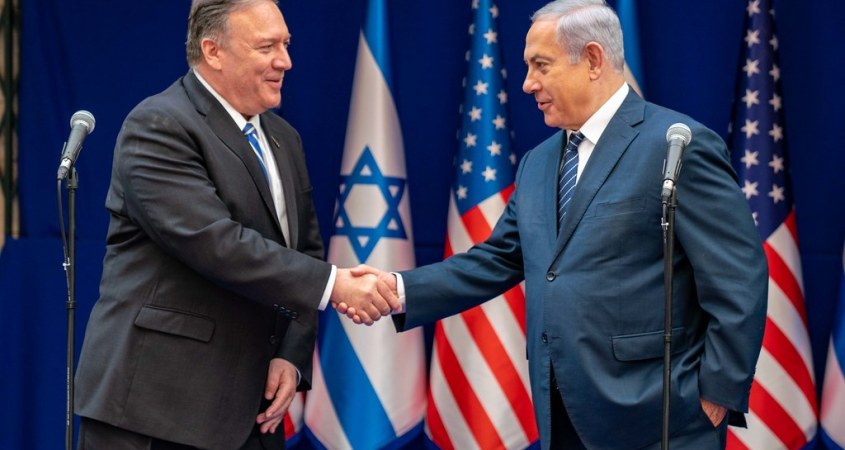Our “Swiss doctor” team provided the following information on the current situation in order to enable our readers to make a realistic risk assessment. (Below you will find regular, but not daily, updates on medical and political developments.)
***
According to the latest data of the Italian National Health Institute ISS, the average age of the positively-tested deceased in Italy is currently about 81 years. 10% of the deceased are over 90 years old. 90% of the deceased are over 70 years old.
80% of the deceased had suffered from two or more chronic diseases. 50% of the deceased had suffered from three or more chronic diseases. The chronic diseases include in particular cardiovascular problems, diabetes, respiratory problems and cancer.
Less than 1% of the deceased were healthy persons, i.e. persons without pre-existing chronic diseases. Only about 30% of the deceased are women.
The Italian Institute of Health moreover distinguishes between those who died from the coronavirus and those who died with the coronavirus. In many cases it is not yet clear whether the persons died from the virus or from their pre-existing chronic diseases or from a combination of both.
The two Italians deceased under 40 years of age (both 39 years old) were a cancer patient and a diabetes patient with additional complications. In these cases, too, the exact cause of death was not yet clear (i.e. if from the virus or from their pre-existing diseases).
The partial overloading of the hospitals is due to the general rush of patients and the increased number of patients requiring special or intensive care. In particular, the aim is to stabilize respiratory function and, in severe cases, to provide anti-viral therapies.
(Update: The Italian National Institute of Health published a statistical report on test-positive patients and deceased, confirming the above data.)
The doctor also points out the following aspects:
Northern Italy has one of the oldest populations and the worst air quality in Europe, which has already led to an increased number of respiratory diseases and deaths in the past and is likely an additional risk factor in the current epidemic.
South Korea, for instance, has experienced a much milder course than Italy and has already passed the peak of the epidemic. In South Korea, only about 70 deaths with a positive test result have been reported so far. As in Italy, those affected were mostly high-risk patients.
The few dozen test-positive Swiss deaths so far were also high-risk patients with chronic diseases, an average age of more than 80 years and a maximum age of 97 years, whose exact cause of death, i.e. from the virus or from their pre-existing diseases, is not yet known.
Furthermore, according to a first Chinese study, the internationally used virus test kits may give a false positive result in some cases. In these cases, the persons may not have contracted the new coronavirus, but presumably one of the many existing human coronaviruses that are part of the annual (and currently ongoing) common cold and flu epidemics. (1)
Thus the most important indicator for judging the danger of the disease is not the frequently reported number of positively-tested persons and deaths, but the number of persons actually and unexpectedly developing or dying from pneumonia (so-called excess mortality).
According to all current data, for the healthy general population of school and working age, a mild to moderate course of the Covid-19 disease can be expected. Senior citizens and persons with existing chronic diseases should be protected. The medical capacities should be optimally prepared.
Medical literature
(1) Zhuang et al., Potential false-positive rate among the ‚asymptomatic infected individuals‘ in close contacts of COVID-19 patients, Chinese Medical Association Publishing House, March 2020.
(2) Grasselli et al., Critical Care Utilization for the COVID-19 Outbreak in Lombardy, JAMA, March 2020.
(3) WHO, Report of the WHO-China Joint Mission on Coronavirus Disease 2019, February 2020.
Reference values
Important reference values include the number of annual flu deaths, which is up to 8,000 in Italy and up to 60,000 in the US; normal overall mortality, which in Italy is up to 2,000 deaths per day; and the average number of pneumonia cases per year, which in Italy is over 120,000.
Current all-cause mortality in Europe and in Italy is still normal or even below-average. Any excess mortality due to Covid-19 should become visible in the European monitoring charts.

Winter smog (NO2) in Northern Italy in February 2020 (ESA)
Updates
March 17, 2020 (I)
- The mortality profile remains puzzling from a virological point of view because, in contrast to influenza viruses, children are spared and men are affected about twice as often as women. On the other hand, this profile corresponds to natural mortality, which is close to zero for children and almost twice as high for 75-year-old men as for women of the same age.
- The younger test-positive deceased almost always had severe pre-existing conditions. For example, a 21-year-old Spanish soccer coach had died test-positive, making international headlines. However, the doctors diagnosed an unrecognized leukemia, whose typical complications include severe pneumonia.
- The decisive factor in assessing the danger of the disease is therefore not the number of test-positive persons and deceased, which is often mentioned in the media, but the number of people actually and unexpectedly developing or dying from pneumonia (so-called excess mortality). So far, this value remains very low in most countries.
- In Switzerland, some emergency units are already overloaded simply because of the large number of people who want to be tested. This points to an additional psychological and logistical component of the current situation.
March 17, 2020 (II)
- Italian immunology professor Sergio Romagnani from the University of Florence comes to the conclusion in a study on 3000 people that 50 to 75% of the test-positive people of all ages remain completely symptom-free – significantly more than previously assumed.
- The occupancy rate of the North Italian ICUs in the winter months is typically already 85 to 90%. Some or many of these existing patients could also be test-positive by now. However, the number of additional unexpected pneumonia cases is not yet known.
- A hospital doctor in the Spanish city of Malaga writes on Twitter that people are currently more likely to die from panic and systemic collapse than from the virus. The hospital is being overrun by people with colds, flu and possibly Covid19 and doctors have lost control.
March 18, 2020
- A new epidemiological study (preprint) concludes that the fatality of Covid19 even in the Chinese city of Wuhan was only 0.04% to 0.12% and thus rather lower than that of seasonal flu, which has a mortality rate of about 0.1%. As a reason for the overestimated fatality of Covid19, the researchers suspect that initially only a small number of cases were recorded in Wuhan, as the disease was probably asymptomatic or mild in many people.
- Chinese researchers argue that extreme winter smog in the city of Wuhan may have played a causal role in the outbreak of pneumonia. In the summer of 2019, public protests were already taking place in Wuhan because of the poor air quality.
- New satellite images show how Northern Italy has the highest levels of air pollution in Europe, and how this air pollution has been greatly reduced by the quarantine.
- A manufacturer of the Covid19 test kit states that it should only be used for research purposes and not for diagnostic applications, as it has not yet been clinically validated.

Datasheet of Covid19 virus test kit
March 19, 2020 (I)
The Italian National Health Institute ISS has published a new report on test-positive deaths:
- The median age is 80.5 years (79.5 for men, 83.7 for women).
- 10% of the deceased was over 90 years old; 90% of the deceased was over 70 years old.
- At most 0.8% of the deceased had no pre-existing chronic illnesses.
- Approximately 75% of the deceased had two or more pre-existing conditions, 50% had three more pre-existing conditions, in particular heart disease, diabetes and cancer.
- Five of the deceased were between 31 and 39 years old, all of them with serious pre-existing health conditions (e.g. cancer or heart disease).
- The National Health Institute hasn’t yet determined what the patients examined ultimately died of and refers to them in general terms as Covid19-positive deaths.
March 19, 2020 (II)
- A report in the Italian newspaper Corriere della Sera points out that Italian intensive care units already collapsed under the marked flu wave in 2017/2018. They had to postpone operations, call nurses back from holiday and ran out of blood donations.
- German virologist Hendrik Streeck argues that Covid19 is unlikely to increase total mortality in Germany, which normally is around 2500 people per day. Streeck mentions the case of a 78-year-old man with preconditions who died of heart failure, subsequently tested positive for Covid19 and thus was included in the statistics of Covid19 deaths.
- According to Stanford Professor John Ioannidis, the new coronavirus may be no more dangerous than some of the common coronaviruses, even in older people. Ioannidis argues that there is no reliable medical data backing the measures currently decided upon.
March 20, 2020
- According to the latest European monitoring report, overall mortality in all countries (including Italy) and in all age groups remains within or even below the normal range so far.
- According to the latest German statistics, the median age of test-positive deaths is about 83 years, most with pre-existing health conditions that might be a possible cause of death.
- A 2006 Canadian study referred to by Stanford Professor John Ioannidis found that common cold coronaviruses may also cause death rates of up to 6% in risk groups such as residents of a care facility, and that virus test kits initially falsely indicated an infection with SARS coronaviruses.
March 21, 2020 (I)
- Spain reports only three test-positive deaths under the age of 65 (out of a total of about 1000). Their pre-existing health conditions and actual cause of death are not yet known.
- On March 20, Italy reported 627 nationwide test-positive deaths in one day. By comparison, normal overall mortality in Italy is about 1800 deaths per day. Since February 21, Italy has reported about 4000 test-positive deaths. Normal overall mortality during this time frame is up to 50,000 deaths. It is not yet known to what extent normal overall mortality has increased, or to what extent it has simply turned test-positive. Moreover, Italy and Europe have had a very mild flu season in 2019/2020 that has spared many otherwise vulnerable people.
- According to Italian news reports, 90% of test-positive deceased in the Lombardy region have died outside of intensive care units, mostly at home or in general care sections. Their cause of death and the possible role of quarantine measures in their deaths remain unclear. Only 260 out of 2168 test-positive persons have died in ICUs.
- Bloomberg highlights that „99% of Those Who Died From Virus Had Other Illness, Italy Says“
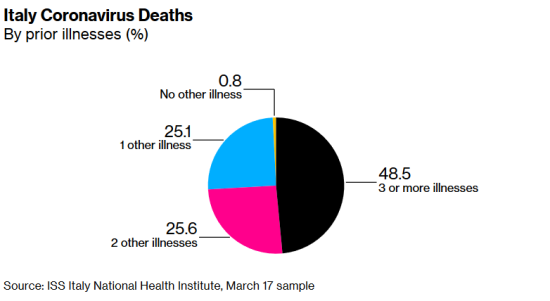
Italy test-positive deaths by prior illnesses (ISS / Bloomberg)
March 21, 2020 (II)
- The Japan Times asks: Japan was expecting a coronavirus explosion. Where is it? Despite being one of the first countries getting positive test results and having imposed no lockdown, Japan is one of the least-affected nations. Quote: „Even if Japan may not be counting all those infected, hospitals aren’t being stretched thin and there has been no spike in pneumonia cases.“
- Italian researchers argue that the extreme smog in Northern Italy, the worst in Europe, may be playing a causative role in the current pneumonia outbreak there, as in Wuhan before.
- In a new interview, Professor Sucharit Bhakdi, a world renowned expert in medical microbiology, says blaming the new coronavirus alone for deaths is „wrong“ and „dangerously misleading“, as there are other more important factors at play, notably pre-existing health conditions and poor air quality in Chinese and Northern Italian cities. Professor Bhakdi describes the currently discussed or imposed measures as „grotesque“, „useless“, „self-destructive“ and a „collective suicide“ that will shorten the lifespan of the elderly and should not be accepted by society.
March 22, 2020 (I)
Regarding the situation in Italy: Most major media falsely report that Italy has up to 800 deaths per day from the coronavirus. In reality, the president of the Italian Civil Protection Service stresses that these are deaths „with the coronavirus and not from the coronavirus“ (minute 03:30 of the press conference). In other words, these persons died while also testing positive.
As Professors Ioannidis and Bhakdi have shown, countries like South Korea and Japan that introduced no lockdown measures have experienced near-zero excess mortality in connection with Covid-19, while the Diamond Princess cruise ship experienced an extra polated mortality figure in the per mille range, i.e. at or below the level of the seasonal flu.
Current test-positive death figures in Italy are still less than 50% of normal daily overall mortality in Italy, which is around 1800 deaths per day. Thus it is possible, perhaps even likely, that a large part of normal daily mortality now simply counts as „Covid19“ deaths (as they test positive). This is the point stressed by the President of the Italian Civil Protection Service.
However, by now it is clear that certain regions in Northern Italy, i.e. those facing the toughest lockdown measures, are experiencing markedly increased daily mortality figures. It is also known that in the Lombardy region, 90% of test-positive deaths occur not in intensive care units, but instead mostly at home. And more than 99% have serious pre-existing health conditions.
Professor Sucharit Bhakdi has called lockdown measures „useless“, „self-destructive“ and a „collective suicide“. Thus the extremely troubling question arises as to what extent the increased mortality of these elderly, isolated, highly stressed people with multiple pre-existing health conditions may in fact be caused by the weeks-long lockdown measures still in force.
If so, it may be one of those cases where the treatment is worse than the disease. (See update below: only 12% of death certificates show the coronavirus as a cause.)
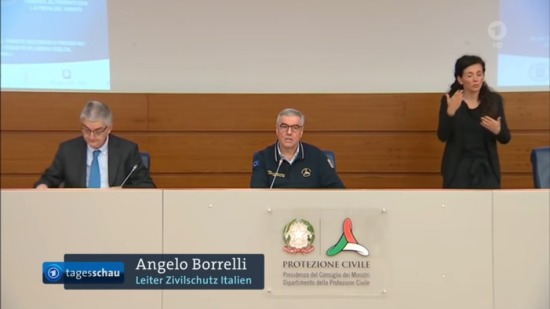
Angelo Borrelli, head of the Italian Civil Protection Service, emphasizing the difference between deaths with and from coronaviruses.
March 22, 2020 (II)
- In Switzerland, there are currently 56 test-positive deaths, all of whom were „high risk patients“ due to their advanced age and/or pre-existing health conditions. Their actual cause of death, i.e. from or simply with the virus, has not been communicated.
- The Swiss government claimed that the situation in southern Switzerland (next to Italy) is „dramatic“, yet local doctors denied this and said everything is normal.
- According to press reports, oxygen bottles may become scarce. The reason, however, is not a currently higher usage, but rather hoarding due to fear of future shortages.
- In many countries, there is already an increasing shortage of doctors and nurses. This is primarily because healthcare workers testing positive have to self-quarantine, even though in many cases they will remain fully or largely symptom-free.
March 22, 2020 (III)
- A model from Imperial College London predicted between 250,000 and 500,000 deaths in the UK „from“ Covid-19, but the authors of the study have now conceded that many of these deaths would not be in addition to, but rather part of the normal annual mortality rate, which in the UK is about 600,000 people per year. In other words, excess mortality would remain low.
- Dr. David Katz, founding director of the Yale University Prevention Research Center, asks in the New York Times: „Is Our Fight Against Coronavirus Worse Than the Disease? There may be more targeted ways to beat the pandemic.“
- According to Italian Professor Walter Ricciardi, „only 12% of death certificates have shown a direct causality from coronavirus“, whereas in public reports „all the people who die in hospitals with the coronavirus are deemed to be dying of the coronavirus“. This means that Italian death figures reported by the media have to be reduced by at least a factor of 8 to obtain actual deaths caused by the virus. Thus one ends up with at most a few dozen deaths per day, compared to an overall daily mortality of 1800 deaths and up to 20,000 flu deaths per year.
March 23, 2020 (I)
- A new French study in the Journal of Antimicrobial Agents, titled SARS-CoV-2: fear versus data, concludes that „the problem of SARS-CoV-2 is probably overestimated“, since „the mortality rate for SARS-CoV-2 is not significantly different from that for common coronaviruses identified at the study hospital in France“.
- An Italian study of August 2019 found that flu deaths in Italy were between 7,000 and 25,000 in recent years. This value is higher than in most other European countries due to the large elderly population in Italy, and much higher than anything attributed to Covid-19 so far.
- In a new fact sheet, the World Health Organization WHO reports that Covid-19 is in fact spreading slower, not faster, than influenza by a factor of about 50%. Moreover, pre-symptomatic transmission appears to be much lower with Covid-19 than with influenza.
- A leading Italian doctor reports that „strange cases of pneumonia“ were seen in the Lombardy region already in November 2019, raising again the question if they were caused by the new virus (which officially only appeared in Italy in February 2020), or by other factors, such as the dangerously high smog levels in Northern Italy.
- Danish researcher Peter Gøtzsche, founder of the renowned Cochrane Medical Collaboration, writes that Corona is „an epidemic of mass panic“ and „logic was one of the first victims.“
March 23, 2020 (II)
- Former Israeli Health Minister, Professor Yoram Lass, says that the new coronavirus is „less dangerous than the flu“ and lockdown measures „will kill more people than the virus“. He adds that „the numbers do not match the panic“ and „psychology is prevailing over science“. He also notes that „Italy is known for its enormous morbidity in respiratory problems, more than three times any other European country.“
- Pietro Vernazza, a Swiss infectious disease specialist, argues that many of the imposed measures are not based on science and should be reversed. According to Vernazza, mass testing makes no sense because 90% of the population will see no symptoms, and lockdowns and closing schools are even „counterproductive“. He recommends protecting only risk groups while keeping the economy and society at large undisturbed.
- The President of the World Doctors Federation, Frank Ulrich Montgomery, argues thatlockdown measures as in Italy are „unreasonable“ and „counterproductive“ and should be reversed.
- Switzerland: Despite media panic, excess mortality still at or near zero: the latest testpositive „victims“ were a 96yo in palliative care and a 97yo with pre-existing conditions.
- The latest statistical report of the Italian National Health Institute is now available in English.
March 24, 2020
- The UK has removed Covid19 from the official list of High Consquence Infectious Diseases (HCID), stating that mortality rates are „low overall“.
- The director of the German National Health Institute (RKI) admitted that they count all test-positive deaths, irrespective of the actual cause of death, as „coronavirus deaths“. The average age of the deceased is 82 years, most with serious preconditions. As in most other countries, excess mortality due Covid19 is likely to be near zero in Germany.
- Beds in Swiss intensive care units reserved for Covid19 patients are still „mostly empty“.
- German Professor Karin Moelling, former Chair of Medical Virology at the University of Zurich, stated in an interview that Covid19 is „no killer virus“ and that „panic must end“.
- In Italy, overall national mortality of the 65+ age group until March 7 remained below the level of earlier years, especially due to the rather mild winter (see red line in chart below).
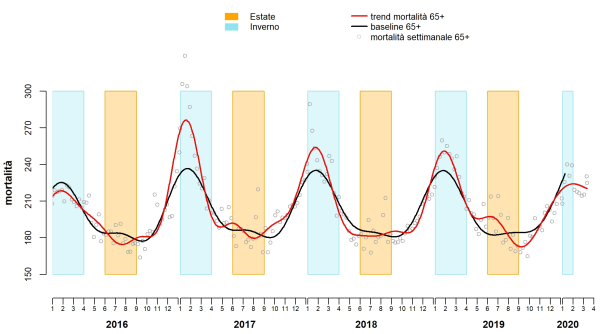
Italy: Overall mortality of 65+ age group (red) compared to earlier years (March 7, 2020 / MdS)
March 25, 2020
- German immunologist and toxicologist, Professor Stefan Hockertz, explains in a radio interview that Covid19 is no more dangerous than influenza (the flu), but that it is simply observed much more closely. More dangerous than the virus is the fear and panic created by the media and the „authoritarian reaction“ of many governments. Professor Hockertz also notes that most so-called „corona deaths“ have in fact died of other causes while also testing positive for coronaviruses. Hockertz believes that up to ten times more people than reported already had Covid19 but noticed nothing or very little.
- The Argentinean virologist and biochemist Pablo Goldschmidt explains that Covid19 is no more dangerous than a bad cold or the flu. It is even possible that the Covid19 virus circulated already in earlier years, but wasn’t discovered because no one was looking for it. Dr. Goldschmidt speaks of a „global terror“ created by the media and politics. Every year, he says, three million newborns worldwide and 50,000 adults in the US alone die of pneumonia.
- Professor Martin Exner, head of the Institute for Hygiene at the University of Bonn, explains in an interview why health personnel are currently under pressure, even though there has hardly been any increase in the number of patients in Germany so far: On the one hand, doctors and nurses who have tested positive have to be quarantined and are often hard to replace. On the other hand, nurses from neighbouring countries, who provide an important part of the care, are currently unable to enter the country due to closed borders.
- Professor Julian Nida-Ruemelin, former German Minister of State for Culture and Professor of Ethics, points out that Covid19 poses no risk to the healthy general population and that extreme measures such as curfews are therefore not justified.
- Using data from the cruise ship Diamond Princess, Stanford Professor John Ioannidis showed that the age-corrected lethality of Covid19 is between 0.025% and 0.625%, i.e. in the range of a strong cold or the flu. Moreover, a Japanese study showed that of all the test-positive passengers, and despite the high average age, 48% remained completely symptom-free; even among the 80-89 year olds 48% remained symptom-free, while among the 70 to 79 year olds it was an astounding 60% that developed no symptoms at all. This again raises the question whether the pre-existing diseases are not perhaps a more important factor than the virus itself. The Italian example has shown that 99% of test-positive deaths had one or more pre-existing conditions, and even among these, only 12% of the death certificates mentioned Covid19 as a causal factor.
March 26, 2020 (I)
- USA: The latest US data of March 25 shows a decreasing number of flu-like illnesses throughout the country, the frequency of which is now well below the multi-year average. The government measures can be ruled out as a reason for this, as they have been in effect for less than a week.

USA: Decreasing flu-like illnesses (March 25, 2020, KINSA)
- Germany: The latest influenza report of the German Robert Koch Institute of March 24 documents a „nationwide decrease in activity of acute respiratory diseases“: The number of influenza-like illnesses and the number of hospital stays caused by them is below the level of previous years and is currently continuing to decline. The RKI continues: „The increase in the number of visits to the doctor () in adults cannot currently be explained either by influenza viruses circulating in the population or by SARS-CoV-2.“
Germany: Decreasing flu-like illnesses (20 March 2020, RKI)
- Italy: The renowned Italian virologist Giulio Tarro argues that the mortality rate of Covid19 is below 1% even in Italy and is therefore comparable to influenza. The higher values only arise because no distinction is made between deaths with and by Covid19 and because the number of (symptom-free) infected persons is greatly underestimated.
- UK: The authors of the British Imperial College study, who predicted up to 500,000 deaths, are again reducing their forecasts. After already admitting that a large proportion of test-positive deaths are part of normal mortality, they now state that the peak of the disease may be reached in two to three weeks already.
- UK: The British Guardian reported in February 2019 that already in the otherwise weak flu season 2018/2019 there were more than 2180 flu-related admissions to intensive care units in the UK.
- Switzerland: In Switzerland, the excess mortality due to Covid19 is apparently still zero. The latest „fatal victim“ presented by the media is a 100-year-old woman. Nevertheless, the Swiss government continues to tighten restrictive measures.
March 26, 2020 (II)
- Sweden: Sweden has so far pursued the most liberal strategy in dealing with Covid19, which is based on two principles: Risk groups are protected and people with flu symptoms stay at home. „If you follow these two rules, there is no need for further measures, the effect of which is only marginal anyway,“ said chief epidemiologist Anders Tegnell. Social and economic life will continue normally. The big rush to hospitals has so far failed to materialize, Tegnell said.
- German criminal and constitutional law expert Dr. Jessica Hamed argues that measures such as general curfews and contact bans are a massive and disproportionate encroachment on fundamental rights of freedom and are therefore presumably „all illegal“.
- The latest European monitoring report on overall mortality continues to show normal or below-average values in all countries and all age groups, but now with one exception: in the 65+ age group in Italy a currently increased overall mortality is predicted (so-called delay-adjusted z-score), which is, however, still below the values of the influenza waves of 2017 and 2018.
March 27, 2020 (I)
Italy: According to the latest data published by the Italian Ministry of Health, overall mortality is now significantly higher in all age groups over 65 years of age, after having been below average due to the mild winter. Until March 14, overall mortality was still below the flu season of 2016/2017, but may have already exceeded it in the meantime. Most of this excess mortality currently comes from northern Italy. However, the exact role of Covid19, compared to other factors such as panic, healthcare collapse and the lockdown itself, is not yet clear.
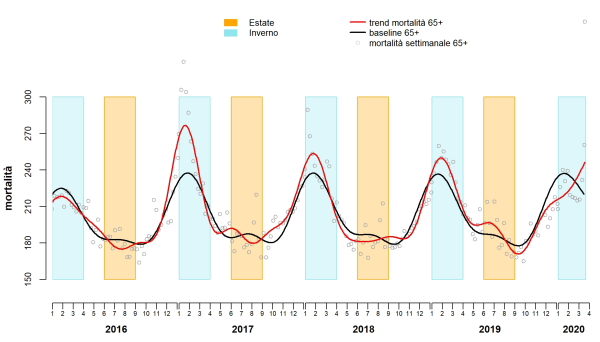
Italy: Total mortality 65+ years (red line) (MdS / 14 March 2020)
France: According to the latest data from France, overall mortality at the national level remains within the normal range after a mild influenza season. However, in some regions, particularly in the north-east of France, overall mortality in the over-65 age group has already risen sharply in connection with Covid19 (see figure below).

France: Total mortality at national level (above) and in the severely affected Haut-Rhin department (SPF / 15 March 2020)
France also provides detailed information on the age distribution and pre-existing conditions of test-positive intensive care patients and deceased patients (see figure below):
- The average age of the deceased is 81.2 years.
- 78% of the deceased were over 75 years old; 93% were over 65 years old.
- 2.4% of the deceased were under 65 years of age and had no (known) previous illness
- The average age of intensive care patients is 65 years.
- 26% of intensive care patients are over 75 years old; 67% have previous illnesses.
- 17% of intensive care patients are under 65 years of age and have no previous illnesses.
The French authorities add that „the share of the (Covid-19) epidemic in overall mortality remains to be determined.“
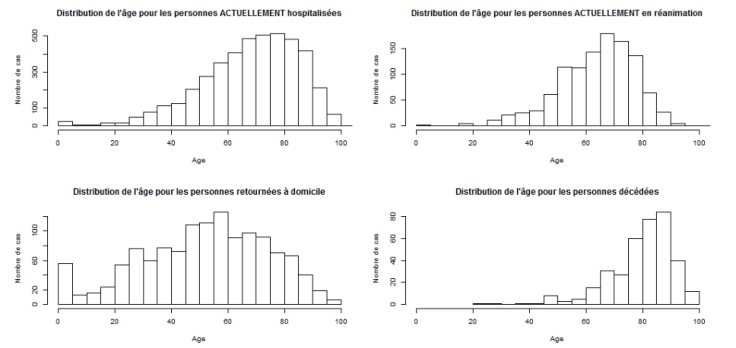
Age distribution of hospitalized patients (top left), intensive care patients (top right), patients at home (bottom left), and the deceased (bottom right). Source: SPF / 24 March 2020
USA: Researcher Stephen McIntyre has evaluated the official data on deaths from pneumonia in the US. There are usually between 3000 and 5500 deaths per week and thus significantly more than the current figures for Covid19. The total number of deaths in the US is between 50,000 and 60,000 per week. (Note: In the graph below, the latest figures for March 2020 have not yet been fully updated, so the curve is slumping).

USA: Deaths from pneumonia per week (CDC/McIntyre)
Great Britain:
- Neil Ferguson of Imperial College London now assumes that the UK has sufficient capacity in intensive care units to treat Covid19 patients.
- John Lee, Professor Emeritus of Pathology, argues that the particular way in which Covid-19 cases are registered leads to an overestimation of the risk posed by Covid19 compared to normal flu and cold cases.
Other topics:
- A preliminary study by researchers at Stanford University showed that 20 to 25% of Covid19-positive patients tested additionally positive for other influenza or cold viruses.
- The number of applications for unemployment insurance in the US skyrocketed to a record of over three million. In this context, a sharp increase in suicides is also expected.
- The first test-positive patient in Germany has now recovered. According to his own statement, the 33-year-old man had experienced the illness „not as bad as the flu“.
- Spanish media report that the antibody rapid tests for Covid19 only have a sensitivity of 30%, although it should be at least 80%.
- A study from China in 2003 concluded that the probability of dying from SARS is 84% higher in people exposed to moderate air pollution than in patients from regions with clean air. The risk is even 200% higher among people from areas with heavily polluted air.
- The German Network for Evidence-Based Medicine (EbM) criticises the media reporting on Covid19: „The media coverage does not in any way take into account the criteria of evidence-based risk communication that we have demanded. () The presentation of raw data without reference to other causes of death leads to an overestimation of the risk“.
March 27, 2020 (II)
- German researcher Dr. Richard Capek argues in a quantitative analysis that the „Corona epidemic“ is in fact an „epidemic of tests“. Capek shows that while the number of tests has increased exponentially, the proportion of infections has remained stable and mortality has decreased, which speaks against an exponential spread of the virus itself (see below).
- German Virology professor Dr. Carsten Scheller from the University of Würzburg explains in a podcast that Covid19 is definitely comparable with influenza and has so far even led to fewer deaths. Professor Scheller suspects that the exponential curves often presented in the media have more to do with the increasing number of tests than with an unusual spread of the virus itself. For countries like Germany, Italy is less of a role model than Japan and South Korea. Despite millions of Chinese tourists and only minimal social restrictions, these countries have not yet experienced a Covid19 crisis. One reason for this could be the wearing of mouth masks: This would hardly protect against infection, but would limit the spread of the virus by infected people.
- The latest figures from Bergamo (city) show that total mortality in March 2020 increased from typically 150 people per month to around 450 people. It is still unclear what proportion of this was due to Covid19 and what proportion was due to other factors such as mass panic, systemic collapse and the lockdown itself. Apparently the city hospital was overrun by people from the whole region and collapsed.
- The two Stanford professors of medicine, Dr. Eran Bendavid and Dr. Jay Bhattacharya, explain in an article that the lethality of Covid19 is overestimated by several orders of magnitude and is probably even in Italy only at 0.01% to 0.06% and thus below that of influenza. The reason for this overestimation is the greatly underestimated number of people already infected (without symptoms). As an example, the fully tested Italian community of Vo is mentioned, which showed 50 to 75% symptom-free test-positivepersons.
- Dr. Gerald Gaß, President of the German Hospital Association, explained in an interview with the Handelsblatt that „the extreme situation in Italy is mainly due to the very low intensive care capacities“.
- Dr. Wolfgang Wodarg, one of the early and vocal critics of a „Covid19 panic“, was provisionally excluded by the board of Transparency International Germany, where he headed the health working group. Wodarg had already been severely attacked by the media for his criticism.
- NSA whistleblower Edward Snowden warns that governments are using the current situation to expand the surveillance state and restrict fundamental rights. The control measures currently put in place would not be dismantled after the crisis.
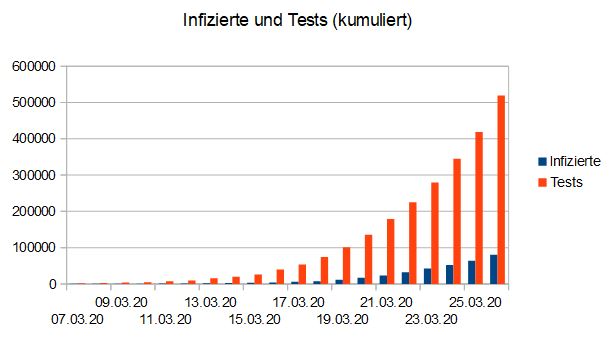
Number of tests and test-positives (proportional)

Test-positives per number of tests (constant)
The increasing number of tests is finding a proportional number of infections, the ratio stays constant, speaking against an ongoing viral epidemic (Dr. Richard Capek, US data)
March 28, 2020
- A new study by the University of Oxford concludes that Covid19 may already have existed in the UK since January 2020 and that half of the population may already be immunised, with most people experiencing no or only mild symptoms. This would mean that only one in a thousand people would need to be hospitalised for Covid19. (Study)
- British media reported on a 21 year old woman „who died of Covid19 without any previous illnesses“. However, it has since become known that the woman did not test positive for Covid19 and died of a heart failure. The Covid19 rumor had arisen „because she had a slight cough“.
- The German media scientist Professor Otfried Jarren criticized that many media provide uncritical journalism that emphasizes threats and executive power. According to Professor Jarren, there is hardly any differentiation and real debate between experts.
March 29, 2020
- Dr Sucharit Bhakdi, Professor Emeritus of Medical Microbiology in Mainz, Germany, wrote an Open Letter to German Chancellor Dr Angela Merkel, calling for an urgent reassessment of the response to Covid19 and asking the Chancellor five crucial questions.
- The latest data from the German Robert Koch Institute show that the increase in test-positive persons is proportional to the increase in the number of tests, i.e. in percentage terms it remains roughly the same. This may indicate that the increase in the number of cases is mainly due to an increase in the number of tests, and not due to an ongoing epidemic.
- The Milan microbiologist Maria Rita Gismondo calls on the Italian government to stop communicating the daily number of „corona positives“ as these figures are „fake“ and put the population in unnecessary panic. The number of test-positives depends very much on the type and number of tests and says nothing about the state of health.
- Dr. John Ioannidis, Stanford Professor of Medicine and Epidemiology, gave an in-depth one-hour interview on the lack of data for Covid19 measures.
- The Argentinean virologist Pablo Goldschmidt, who lives in France, considers the political reaction to Covid19 as „completely exaggerated“ and warns against „totalitarian measures“. In parts of France, the movement of people is already monitored by drones.
- Italian author Fulvio Grimaldi, born in 1934, explains that the state measures currently implemented in Italy are „worse than under fascism“. Parliament and society have been completely disempowered.
March 30, 2020 (I)
- In Germany, some clinics can no longer accept patients – not because there are too many patients or too few beds, but because the nursing staff have tested positive, although in most cases they hardly show any symptoms. This case illustrates again how and why health care systems are getting paralysed.
- In a German retirement and nursing home for people with advanced dementia, 15 test-positive people have died. However, „surprisingly many people have died without showing symptoms of corona.“ A German medical specialist informs us: „From my medical point of view, there is some evidence that some of these people may have died as a result of the measures taken. People with dementia get into high stress when major changes are made to their everyday lives: isolation, no physical contact, possibly hooded staff.“ Nevertheless, the deceased are counted as „corona deaths“ in German and international statistics. In connection with the „corona crisis“, it is now also possible to die of an illness without even having its symptoms.
- According to a Swiss pharmacologist, the Swiss Inselspital in Bern has forced staff to take leave, stopped therapies and postponed operations due to the fear of Covid19.
- Professor Gérard Krause, head of the Department of Epidemiology at the German Helmholtz Centre for Infection Research, warns on German public television ZDF that the anti-corona measures „could lead to more deaths than the virus itself„.
- Various media reported that more than 50 doctors in Italy have already died „during the corona crisis“, like soldiers in a battle. A glance at the corresponding list, however, shows that most of the deceased are retired doctors of various kinds, including 90-year-old psychiatrists and pediatricians, many of whom may have died of natural causes.
- An extensive survey in Iceland found that 50% of all test-positive persons showed „no symptoms“ at all, while the other 50% mostly showed „very moderate cold-like symptoms“. According to the Icelandic data, the mortality rate of Covid19 is in the per mille range, i.e. in the flu range or below. Of the two test-positive deaths, one was „a tourist with unusual symptoms“. (More Icelandic data)
- The British journalist Peter Hitchens writes, „There’s powerful evidence this great panic is foolish. Yet our freedom is still broken and our economy crippled.“ Hitchens points out that in parts of the UK, police drones monitor and report „non-essential“ walks in nature. In some cases, police drones are calling on people via loudspeaker to go home in order to „save lives“. (Note: Not even George Orwell had thought that far ahead.)
- The Italian secret service warns of social unrest and uprisings. Supermarkets are already being looted and pharmacies raided.
- Professor Sucharit Bhakdi has meanwhile published a video (German/English) in which he explains his Open Letter to German Chancellor Dr. Angela Merkel.
March 30, 2020 (II)
In several countries, there is increasing evidence in relation to Covid19 that „the treatment could be worse than the disease“.
On the one hand, there is the risk of so-called nosocomial infections, i.e. infections that the patient, who may only be mildly ill, acquires in hospital. It is estimated that there are approximately 2.5 million nosocomial infections and 50,000 deaths per year in Europe. Even in German intensive care units, about 15% of patients acquire a nosocomial infection, including pneumonia on artificial respiration. There is also the problem of increasingly antibiotic-resistant germs in hospitals.
Another aspect is the certainly well-intentioned but sometimes very aggressive treatment methods that are increasingly used in Covid19 patients. These include, in particular, the administration of steroids, antibiotics and anti-viral drugs (or a combination thereof). Already in the treatment of SARS-1 patients, it has been shown that the outcome with such treatment was often worse and more fatal than without such treatment.
March 31, 2020 (I)
Dr. Richard Capek and other researchers have already shown that the number of test-positive individuals in relation to the number of tests performed remains constant in all countries studied so far, which speaks against an exponential spread („epidemic“) of the virus and merely indicates an exponential increase in the number of tests.
Depending on the country, the proportion of test-positive individuals is between 5 and 15%, which corresponds to the usual spread of corona viruses. Interestingly, these constant numerical values are not actively communicated (or even removed) by authorities and the media. Instead, exponential but irrelevant and misleading curves are shown without context.
Such behavior, of course, does not correspond to professional medical standards, as a look at the traditional influenza report of the German Robert Koch Institute makes clear (p. 30, see chart below). Here, in addition to the number of detections (right), the number of samples (left, grey bars) and the positive rate (left, blue curve) are shown.
This immediately shows that during a flu season the positive rate rises from 0 to 10% to up to 80% of the samples and drops back to the normal value after a few weeks. In comparison, Covid19 tests show a constant positive rate in the normal range (see below).
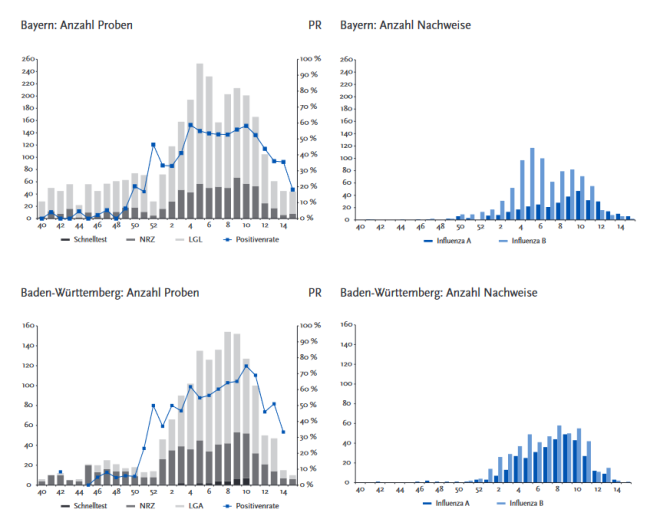
Left: Number of samples and positive rate; right: number of detections (RKI, 2017)
Constant Covid19-positive rate using US data (Dr. Richard Capek). This applies analogously to all other countries for which data on the number of samples is currently available.
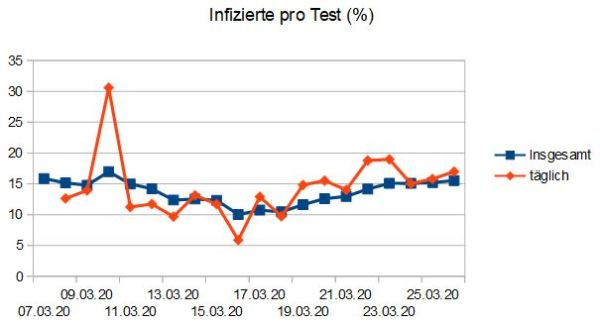
Covid19 positive rate (Dr. Richard Capek, US data)
March 31, 2020 (II)
- A graphical analysis of the European monitoring data impressively shows that, irrespective of the measures taken, overall mortality throughout Europe remained in the normal range or below by March 25, and often significantly below the levels of previous years. Only in Italy (65+) was the overall mortality rate somewhat increased (probably for several reasons), but it was still below previous flu seasons.
- The president of the German Robert Koch Institute confirmed again that pre-existing conditions and actual cause of death do not play a role in the definition of so-called „corona deaths“. From a medical point of view, such a definition is clearly misleading. It has the obvious and generally known effect of putting politics and society in fear.
- In Italy the situation is now beginning to calm down. As far as is known, the temporarily increased mortality rates (65+) were rather local effects, often accompanied by mass panic and a breakdown in health care. A politician from northern Italy asks, for example, „how is it possible that Covid patients from Brescia are transported to Germany, while in the nearby Verona two thirds of intensive care beds are empty?“
- In an article published in the European Journal of Clinical Investigation, Stanford professor of medicine John C. Ioannidis criticizes the „harms of exaggerated information and non-evidence-based measures“. Even journals had published dubious claims at the beginning.
- A Chinese study published in the Chinese Journal of Epidemiology in early March, which indicated the unreliability of the Covid19 virus tests (approx. 50% false-positive results in asymptomatic patients), has since been withdrawn. The lead author of the study, the dean of a medical school, did not want to give the reason for the withdrawal and spoke of a „sensitive matter„, which could indicate political pressure, as an NPR journalist noted. Independent of this study, however, the unreliability of so-called PCR virus tests has long been known: In 2003, for example, a mass infection in a Canadian nursing home with SARS corona viruses was „found“, which later turned out to be common cold corona viruses (which can also be fatal for risk groups).
- Authors of the German Risk Management Network RiskNET speak in a Covid19 analysis of a „blind flight“ as well as „insufficient data competence and data ethics“. Instead of more and more tests and measures a representative sample is necessary. The „sense and ratio“ of the measures must be critically questioned.
- The Spanish interview with the internationally renowned Argentinian-French virologist Pablo Goldschmidt was translated into German. Goldschmidt considers the measures imposed to be medically counterproductive and notes that one must now „read Hannah Arendt“ to understand the „origins of totalitarianism“.
- Hungarian Prime Minister Viktor Orban, like other prime ministers and presidents before him, has largely disempowered the Hungarian parliament under an „emergency law“ and can now govern essentially by decree.
April 1, 2020
On the situation in Italy
Italian doctors reported that they had already observed severe cases of pneumonia in northern Italy at the end of last year. However, genetic analyses now show that the Covid19 virus only appeared in Italy in January of this year. „The severe pneumonia diagnosed in Italy in November and December must therefore be due to a different pathogen,“ a virologist noted. This once again raises the question what role the Covid19 virus, or other factors, actually play in the Italian situation.
On March 30, we mentioned the list of Italian doctors who died „during the Corona crisis“, many of whom were up to 90 years old and didn’t actively participate in the crisis at all. Today, all years of birth on the list have been removed (see however the last archive version). A strange procedure.
We have also received the following message from an observer in Italy, who gives further details about the dramatic situation there, which is obviously due to far more than a virus:
„In recent weeks, most of the Eastern European nurses who worked 24 hours a day, 7 days a week supporting people in need of care in Italy have left the country in a hurry. This is not least because of the panic-mongering and the curfews and border closures threatened by the „emergency governments“. As a result, old people in need of care and disabled people, some without relatives, were left helpless by their carers.
Many of these abandoned people then ended up after a few days in the hospitals, which had been permanently overloaded for years, because they were dehydrated, among other things. Unfortunately, the hospitals lacked the personnel who had to look after the children locked up in their apartments because schools and kindergartens had been closed. This then led to the complete collapse of the care for the disabled and the elderly, especially in those areas where even harder „measures“ were ordered, and to chaotic conditions.
The nursing emergency, which was caused by the panic, temporarily led to many deaths among those in need of care and increasingly among younger patients in the hospitals. These fatalities then served to cause even more panic among those in charge and the media, who reported, for example, „another 475 fatalities“, „The dead are being removed from hospitals by the army“, accompanied by pictures of coffins and army trucks lined up.
However, this was the result of the funeral directors‘ fear of the „killer virus“, who therefore refused their services. Moreover, on the one hand there were too many deaths at once and on the other hand the government passed a law that the corpses carrying the coronavirus had to be cremated. In Catholic Italy, few cremations had been carried out in the past. Therefore there were only a few small crematoria, which very quickly reached their limits. Therefore the deceased had to be laid out in different churches.
In principle, this development is the same in all countries. However, the quality of the health system has a considerable influence on the effects. Therefore, there are fewer problems in Germany, Austria or Switzerland than in Italy, Spain or the USA. However, as can be seen in the official figures, there is no significant increase in the mortality rate. Just a small mountain that came from this tragedy.“
Hospital situation in the US, Germany and Switzerland
- The US television station CBS was caught using footage from an Italian intensive care unit in a piece on the current situation in New York. In fact, dozens of recordings by citizen journalists show that it is currently very quiet in the hospitals on the US East and West Coast, described as „war zones“ by the media. Even the „corpse refrigerator trucks“ prominently shown in the media are unused and empty.
- Contrary to media reports, the register of German intensive care units also shows no increased occupancy. An employee of a Munich clinic explained that they had been „waiting for weeks for the wave to hit“, but that there was „no increase in patient numbers“. He said that the politicians‘ statements did not correspond with their own experience, and that the „myth of the killer virus“ could „not be confirmed“.
- Also in Swiss clinics, no increased occupancy has been observed so far. A visitor to the cantonal hospital in Lucerne reports that there is „less activity than in normal times“. Entire floors have been closed for Covid19, but staff „are still waiting for patients“. The hospitals in Bern, Basel, Zug and Zurich have also been „cleaned out“. Even in Ticino, the intensive care units are not working to capacity, but patients are now being transferred to the German-Swiss departments. From a purely medical point of view, this makes little sense.
Other medical notes
- The director of the University Medical Center Hamburg, Dr. Ansgar Lohse, demands a quick end to curfews and contact bans. He argues that more people should be infected with corona. Kitas and schools should be reopened as soon as possible so that children and their parents can become immune through infection with the corona virus. The continuation of the strict measures would lead to an economic crisis, which would also cost lives, said the physician.
- In Spain, 15% of test-positives are doctors and nurses. Although many of them show no symptoms, they have to go into quarantine, causing the Spanish healthcare system to collapse.
- Dr. John Lee, professor emeritus of pathology, is writing about the highly misleading definition and communication of „corona deaths“ in the British Spectator.
- The latest data from Norway, evaluated by a PhD in environmental toxicology, again show that the rate of test-positives does not increase – as would be expected in the case of an epidemic – but fluctuates in the normal range for coronaviruses between 2 and 10%. The average age of the test-positive deceased is 84 years, the causes of death are not publicly reported, and there is no excess mortality.
- Sweden, which has so far managed without radical measures and has not reported increased mortality (similar to Asian countries such as Japan or South Korea), is remarkably put under pressure from the international media to change its strategy.
- Data from New York State show that the hospitalization rate of test-positive individuals could be more than twenty times lower than originally assumed.
- An article on the specialist portal DocCheck deals with the problem of ventilating test-positive patients. In test-positive patients, simple ventilation through a mask is officially advised against, among other things to prevent the coronavirus from spreading through aerosols. Therefore, test positive intensive care patients are often intubated directly. However, intubation has poor chances of success and often leads to additional damage to the lungs (so-called ventilator-induced lung damage). As with medication, the question arises as to whether a more gentle treatment of patients would not be medically more sensible.
Reports on political developments
- A German state minister has called on the population to „be vigilant and report violations of the rules for containing the corona epidemic to the police“. „Eagerly reported“ are, for example, „prohibited group formation, children in playgrounds, parties“ and hikers.
- German constitutional law experts are raising the alarm for „serious encroachments on fundamental rights“. Constitutional law expert Hans Michael Heinig warns that the „democratic constitutional state could turn into a fascist-hysterical hygiene state in no time“. Professor Christoph Möllers of Berlin’s Humboldt University explains that the infection protection law „cannot serve as a basis for such far-reaching restrictions of citizens‘ rights of freedom“. According to the former president of the German Federal Constitutional Court, Hans Jürgen Papier, „emergency measures do not justify the suspension of civil liberties in favour of an authoritarian and surveillance state“.
- Online petitions have been launched in several countries to end curfews and other encroachments on basic rights. At the same time, critical video contributions, even by doctors, are increasingly being deleted. In Berlin, a registered event on fundamental rights, at which the German constitution was distributed, was terminated by the police.
April 2, 2020 (I)
USA
A Swiss biophysicist has visualized the fact that in the US (as in the rest of the world), it is not the number of „infected“ people that is increasing exponentially, but the number of tests. The number of test-positive people in relation to the number of tests remains constant or increases slowly, which appears to speak against an exponential viral epidemic.

Number of positive and negative tests (left) and percantage of positive tests (right) (Scholkmann, US data)
Germany
According to the latest influenza report of the German Robert Koch Institute, the number of acute respiratory diseases has „fallen sharply nationwide“. The values have „dropped in all age groups“.
By March 20, the total number of inpatient cases with acute respiratory diseases had also fallen significantly. In the age group from 80 years and older, the number of cases had almost halved compared to the previous week.
In the 73 hospitals examined, 7% of all cases with respiratory diseases were diagnosed with COVID-19. In the age groups 35-59 years it was 16% and in the age group 60-79 years it was 13% who received a COVID-19 diagnosis.
These figures correspond to those from other countries as well as to the typical prevalence of coronaviruses (5 to 15%).

Grippeähnliche Erkrankungen (RKI, KW13)
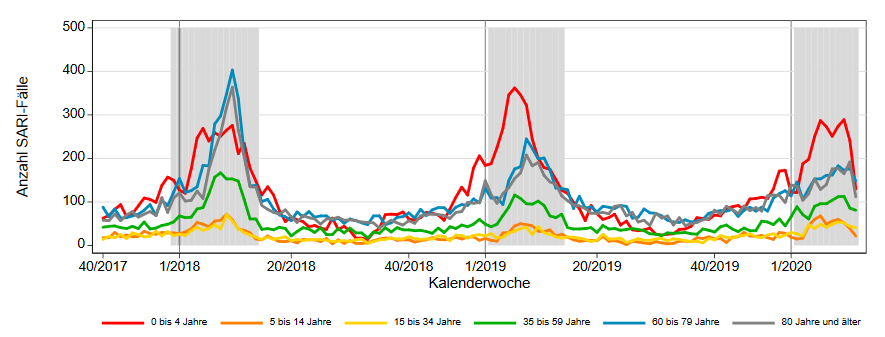
Akute Atemwegserkrankungen in Krankenhäusern
Flu-like diseases in general (left) and acute respiratory diseases in hospitals (right) (Robert-Koch-Institut, weeks 13 and 12)
An article in DIE ZEIT discusses the issue of intensive care patients in Germany:
„At present politicians, experts and many citizens observe with concern the exponentially increasing number of people who are newly infected every day. However, this is not the decisive indicator for assessing how badly the corona crisis is and will hit Germany. For it is distorted above all by the number of tests, which have been increasing for weeks.
In order to measure the burden on the health system, the number of those who are so seriously ill that they need to be ventilated is particularly important. As long as there are enough ventilation places for them, a great many of them can be saved. Only when these beds become scarce does a situation like the one in Italy threaten.
The DIVI register now shows that the situation in the German intensive care units has been relaxed so far. „We are still in a comfortable area,“ says Grabenhenrich. The number of seriously ill patients is not rising as steeply as the number of infected patients and even if it did, it would still be possible to provide a large number of intensive care beds with very good equipment.
Switzerland
The Swiss Federal Office of Public Health reports that approximately 139,330 Covid19 tests have been carried out so far, of which the result was positive in 15% of cases. This number also corresponds to the typical corona virus value known from other countries and, as far as can be seen, does not seem to be increasing in Switzerland either.
Only the number of tests often mentioned in the media is increasing exponentially, but not the number of „infected“, sick or even dead.
On March 31, however, a new weekly mortality statistic was published which for the first time forecasts an increase in overall mortality in the 65+ age group in Switzerland for the 12th calendar week (until 22 March) (see chart below). Specifically, total mortality is expected to increase by around 200 deaths per week.
According to the Federal Office, this increase is „an expression of the current pandemic“. The following problem arises here: up to 22 March there were a total of 106 test-positive deaths in Switzerland. An increase of 200 deaths per week would mean that a large part of the additional mortality is not caused by the virus but by the „countermeasures“.
Another explanation would be that the approximately 200 test-positive deaths of the following week (week 13) have already been included. This would mean that all test-positive deaths are assumed to be additional deaths. However, in view of the age and disease profile as well as international experience, this would be a very doubtful assumption.
In fact, the report adds the following disclaimer: „These initial estimates are still very uncertain, so that no exact figures can be published“.
If it turns out that a large proportion of test-positive deaths (median age: 83 years) are not additional deaths, either the overall mortality would not be increased, or it would be increased mainly because of the drastic measures, as some experts fear.

Weekly mortality until 22 March 2020 (BFS, data status 31 March 2020)
A Swiss newspaper has presented the current total mortality in comparison with previous years (see graph below). This illustrates that, even if actually increased, the current mortality rate is still below the stronger flu winters of recent years.

Weekly mortality during the year. End date is March 22, not March 31 (TA)
Further information
- Virus test kits destined for Great Britain had to be recalled because they already contained corona virus components.
- The British Imperial College study, which predicted hundreds of thousands of additional deaths but was never published in a journal or reviewed, was based on largely unrealistic assumptions, as has now been shown.
- The BBC asks, „Is coronavirus causing the deaths?„, and replies, „It could be the major cause, a contributory factor or simply present when they are dying of something else.“ For example, an 18-year-old man was reported as the „youngest Corona victim“ after a positive test the day before his death. However, the hospital later reported that the young man had died of a serious pre-existing condition.
- The European health authority ECDC has published very strict guidelines for handling test-positive or „presumed test-positive“ corpses. In view of the very low mortality rates to date, such guidelines appear questionable from a medical point of view; however, they significantly increase the burden on the health and funeral services, and at the same time have a high media impact.
- A German state media outlet has published a critical commentary on Professor Sucharit Bhakdi’s Open Letter to Chancellor Merkel.
- The ARTE documentary „Profiteers of Fear“ from 2009 shows how the mainly privately financed WHO „upgraded“ a mild wave of influenza (the so-called „swine flu“) to a global pandemic so that vaccines worth several billion dollars could be sold to governments around the world. Some of the protagonists of that time are again prominently representedin the current situation.
- The former judge at the British Supreme Court, Jonathan Sumption, declared in a BBC interview on the British measures: „This is what a police state is like“.
April 2, 2020 (II)
- Already in 2018, the Guardian wrote that „Pollution and flu bring steep rise in lung-related illnesses„: Shortage of specialists adds to worries that surge in respiratory diseases is putting pressure on A&Es.
- Professor Martin Haditsch, specialist in microbiology, virology and infection epidemiology, sharply criticises the Covid19 measures. These are „completely unfounded“ and would „trample on sound judgment and ethical principles“.
- Even representatives of German nursing homes are now complaining about the restrictive measures and inappropriate media coverage of Covid19: „Even before the coronavirus in the winter months, it often happened that many guests died in a relatively short time, but the television crew did not stand behind the door and did not show people in protective suits heroically exposing themselves to the risk of infection.“
- Figures from the northern Italian city of Treviso (near Venice) show that, despite 108 test-positive deaths by the end of March, overall mortality in municipal hospitals remained roughly the same as in previous years. This is a further indication that the temporarily increased mortality in some places is more likely to be due to external factors such as panic and collapse than due to the coronavirus alone.
- Professor John Oxford of Queen Mary University London, one of the world’s leading virologists and influenza specialists, comes to the following conclusion regarding Covid19: „Personally, I would say the best advice is to spend less time watching TV news which is sensational and not very good. Personally, I view this Covid outbreak as akin to a bad winter influenza epidemic. In this case we have had 8000 deaths this last year in the ‘at risk’ groups viz over 65% people with heart disease etc. I do not feel this current Covid will exceed this number. We are suffering from a media epidemic!“
April 3, 2020
USA: More videos by citizen journalists show that in hospitals described by US media as „war zones“, it is in fact still very quiet.
Austria: In Austria, too, „corona deaths“ are apparently defined „very liberally“, as the media report: „Do you also count as a corona death if you are infected with the virus but die of something else? Yes, say Rudi Anschober and Bernhard Benka, members of the Corona Task Force in the Ministry of Health. „There is a clear rule at present: Died with the corona virus or died from the corona virus both count for the statistics.“ No difference is made as to what the patient actually died of. In other words, a 90-year-old man who dies with a fracture of the femoral neck and becomes infected with corona in the hours prior to his death is also counted as corona death. To name but one example.“
Germany: The German Robert Koch Institute now advises against autopsies of test-positive deceased persons because the risk of droplet infection by aerosols is allegedly too high. In many cases, this means that the real cause of death can no longer be determined.
A specialist in pathology comments on this as follows: „Who might think evil of it! Up to now, it has been a matter of course for pathologists to carry out autopsies with appropriate safety precautions even in the case of infectious diseases such as HIV/AIDS, hepatitis, tuberculosis, PRION diseases, etc. It is quite remarkable that in a disease that is killing thousands of patients all over the world and bringing the economy of entire countries to a virtual standstill, only very few autopsy findings are available (six patients from China). From the point of view of both the epidemic police and the scientific community, there should be a particularly high level of public interest in autopsy findings. However, the opposite is the case. Are you afraid of finding out the true causes of death of the positively tested deceased? Could it be that the numbers of corona deaths would then melt away like snow in the spring sun?“
Italy: Russian experts have noticed „strange deaths“ in nursing homes in Lombardy: „According to newspaper reports, several cases have been registered in the town of Gromo in which alleged corona virus-infected persons simply fell asleep and never woke up again. No real symptoms of the disease had been observed in the deceased until then. () As the director of the nursing home later clarified in an interview with RIA Novosti, it is unclear whether the deceased were actually infected with the coronavirus, because nobody in the home had been tested for it. () In the homes, where medical and nursing teams from Russia are working, corridors, bed rooms and dining rooms are disinfected.“
Similar cases have already been reported from Germany: Nursing patients without symptoms of illness die suddenly in the current exceptional situation and are then considered „corona deaths“. Here again the serious question arises: Who dies from the virus and who dies from the sometimes extreme measures?
Nursing staff: The Süddeutsche Zeitung reports: „Throughout Europe, the pandemic is endangering the care of elderly people at home because nursing staff can no longer visit them – or have left the respective country in a hurry to return home.“
Lastly: Stanford professor of medicine Dr. Jay Bhattacharya gave a half-hour interview in which he questions the „conventional wisdom“ regarding Covid19. The existing measures had been decided on the basis of very uncertain and partly questionable data.
April 5, 2020
- In a 40-minute interview, the internationally renowned epidemiology professor Knut Wittkowski from New York explains that the measures taken on Covid19 are all counterproductive. Instead of „social distancing“, school closures, „lock down“, mouth masks, mass tests and vaccinations, life must continue as undisturbed as possible and immunity must be built up in the population as quickly as possible. According to all findings to date, Covid-19 is no more dangerous than previous influenza epidemics. Isolation now would only cause a „second wave“ later.
- The British Medical Journal (BMJ) reports that, according to the latest data from China, 78% of new test-positive individuals show no symptoms. An Oxford epidemiologist said that these findings are „very, very important.“ He added that if the results are representative, „then we have to ask, ‘What the hell are we locking down for?’“
- Dr. Andreas Sönnichsen, head of the Department of General and Family Medicine at the Medical University of Vienna and chairman of the Network for Evidence-Based Medicine, considers the measures imposed so far to be „insane“. The whole state is being paralysed just to „protect the few it could affect“.
- In a world first, the Swedish government has announced that it is going to officially distinguish between deaths „by“ and deaths „with“ the coronavirus, which should lead to a reduction in reported deaths. Meanwhile, for some reason, international pressure on Sweden to abandon its liberal strategy is steadily increasing.
- The Hamburg health authority now has test-positive deaths examined by forensic medicine in order to count only „real“ corona deaths. As a result, the number of deaths has already been reduced by up to 50% compared to the official figures of the Robert Koch Institute.
- As early as 2018, the German Doctors Journal reported a „multitude of pneumonia cases“in northern Italy, which worried the authorities. At the time, contaminated drinking water was suspected to be one of the causes.
- The German Pharmaceutical Newspaper points out that in the current situation, patients often „fall seriously ill, even die, without having developed respiratory symptoms beforehand“. Neurologists suspect in this regard that the corona viruses could also damage nerve cells. Another explanation, however, would be that these patients, who are often in need of care, die due to the very high stress.
- According to the latest figures from Switzerland, the most common symptoms of test-positive patients in hospitals are fever, cough and breathing difficulties, while 43% or about 900 people have pneumonia. Even in these cases, however, it is not a priori clear whether it was caused by the coronavirus or by other pathogens. The median age of the test positive deceased is 83 years, the range reaches up to 101 years.
- The British project „In Proportion“ tracks mortality „with“ Covid19 in comparison to influenza mortality and all-cause mortality, which in Great Britain is still in the normal range or below and is currently decreasing.
- In the US state of Indiana, calls to the mental health and suicide hotline have increased by over 2000% from 1000 to 25,000 calls per day due to the lockdown and its economic impact.
- The medical specialist portal Rxisk points out that various drugs can increase the risk of infection with corona viruses by up to 200% in some cases.
Further notes
- The British journalist Peter Hitchens describes in an article entitled „We love Big Brother“how even previously critical people were „infected by fear“ despite the lack of medical evidence. In an interview, he explains that criticism is „a moral duty“ as fundamental rights are under threat
- The German historian René Schlott writes about the „Rendezvous with the police state„: „Buying a book, sitting on a park bench, meeting up with friends – that is now forbidden, is controlled and denounced. The democratic safeguards seem to be blown. Where and how will it end?“
- Several German law firms are preparing lawsuits against the measures and regulations that have been issued. A specialist in medical law writes in a press release: „The measures taken by the federal and state governments are blatantly unconstitutional and violate a multitude of basic rights of citizens in Germany to an unprecedented extent. This applies to all corona regulations of the 16 federal states. In particular, these measures are not justified by the Infection Protection Act, which was revised in no time at all just a few days ago. () Because the available figures and statistics show that corona infection is harmless in more than 95% of the population and therefore does not represent a serious danger to the general public.“
- The Open Letter from Professor Sucharit Bhakdi to Chancellor Angela Merkel is now available in German, English, French, Spanish, Russian, Turkish, Dutch and Estonian, other languages will follow.
- In a new interview, NSA whistleblower Edward Snowden warns that Covid19 is dangerous but temporary, while the destruction of fundamental rights is deadly and permanent.
April 7, 2020
- The latest figures from a special report by the German Robert Koch Institute show that the so-called positive rate (i.e. the number of test positives per number of tests) is increasing much more slowly than the exponential curves shown by the media and was only around 10% at the end of March, a value that is rather typical for corona viruses. According to the magazine Multipolar, there can therefore be „no question of a dangerously rapid spread of the virus“.
- Professor Klaus Püschel, head of forensic medicine in Hamburg, explains about Covid19: „This virus influences our lives in a completely excessive way. This is disproportionate to the danger posed by the virus. And the astronomical economic damage now being caused is not commensurate with the danger posed by the virus. I am convinced that the Corona mortality rate will not even show up as a peak in annual mortality.“ In Hamburg, for example, „not a single person who was not previously ill“ had died of the virus: „All those we have examined so far had cancer, a chronic lung disease, were heavy smokers or severely obese, suffered from diabetes or had a cardiovascular disease. The virus was the last straw that broke the camel’s back, so to speak. „Covid-19 is a fatal disease only in exceptional cases, but in most cases it is a predominantly harmless viral infection.“
In addition, Dr. Püschel explains: „In quite a few cases, we have also found that the current corona infection has nothing whatsoever to do with the fatal outcome because other causes of death are present, for example a brain haemorrhage or a heart attack. Corona in itself is a „not particularly dangerous viral disease“, says the forensic scientist. He pleads for statistics based on concrete examination results. „All speculations about individual deaths that have not been expertly examined only fuel anxiety.“ Contrary to the guidelines of the Robert Koch Institute, Hamburg had recently started to differentiate between deaths „with the“ and „by the“ coronavirus, which led to a decrease in Covid19 deaths.
- The German virologist Hendrik Streeck is currently conducting a pilot study to determine the distribution and transmission routes of the Covid19 pathogen. In an interview he explains: „I took a closer look at the cases of 31 of the 40 people who died in the Heinsberg district – and was not very surprised that these people died. One of the deceased was older than 100 years, so even a common cold could have led to death.“ Contrary to original assumptions, Streeck has not been able to prove transmission via door handles and the like (i.e. so-called smear infections).
- The first Swiss hospitals have to announce short-time work due to the very low capacity utilization: „The staff in all departments has too little to do and has reduced overtime in a first step. Now short-time work is also being registered. The financial consequences are severe.“ As a reminder, a study by ETH Zurich based on largely unrealistic assumptions predicted the first bottlenecks in Swiss clinics by April 2. So far this has not happened anywhere.
- In Switzerland, there was a pronounced wave of influenza at the beginning of 2017. At that time, there were almost 1500 additional deaths in the over 65-year-old population in the first six weeks of the year. Normally, around 1300 people die in Switzerland every year as a result of pneumonia, 95% of whom are over 65 years old. By comparison, a total of 762 deaths with (not caused by) Covid19 are currently reported in Switzerland.
- The managing director of a German environmental laboratory suspects that the inhabitants of the northern Italian region of Lombardy are particularly susceptible to viral infections such as Covid19 due to a notoriously high legionella contamination: „If the lungs are weakened by a viral infection, as in the current situation, bacteria have an easy job, can negatively influence the course of the disease and cause complications.“ In Lombardy, regional pneumonia outbreaks had already occurred in the past due to evaporation cooling systems contaminated with legionella.
- On the basis of information from China, medical protocols have been defined worldwide that rapidly provide invasive artificial respiration by intubation for test-positive intensive care patients. On the one hand, the protocols assume that a more gentle non-invasive ventilation through a mask is too weak, on the other hand there is the fear that the „dangerous virus“ could otherwise spread through aerosols. As early as March, however, German physicians pointed out that intubation can lead to additional lung damage and has an overall poor chance of success. In the meantime, US physicians have also come forward who describe intubation as „more harm than good“ for patients. Patients often do not suffer from acute lung failure, but rather from a kind of altitude sickness, which is made worse by artificial respiration with increased pressure. In February, South Korean physicians reported that critical Covid19 patients respond well to oxygen therapy without a ventilator. The US physician mentioned above warns that the use of ventilators must be urgently reconsidered in order not to cause additional damage.
- The official US Covid19 projections so far have overestimated hospitalisations by a factor of 8, ICU beds needed by a factor of 6.4, and ventilators needed by a factor of 40.5.
- Renowned US statistician Nate Silver explains why „coronavirus case counts are meaningless„, unless you know more about the number and way of testing.
Further notes
- The website of Dr. Wolfgang Wodarg, one of the earliest and internationally best known critics of the Covid19 panic, was deleted for a few hours today by the German provider Jimdo and only went online again after strong protests. It is not known whether the temporary deletion was due to general complaints or a political instruction.
- The university email address of emeritus professor Dr. Sucharit Bhakdi, who wrote an Open Letter to Chancellor Angela Merkel, was deactivated earlier, but was also reactivated after protests.
- On April 2, the Danish Parliament adopted a new law that allows the authorities to block „fraudulent“ websites on Covid19 without an initial court order and to impose a higher penalty on the operators. It is still unclear what this means for generally critical websites about Covid19 and government policy in this regard.
- The German author and journalist Harald Wiesendanger writes in an article that his profession is completely failing in the current crisis: „How a profession that is supposed to control the powerful as an independent, critical, impartial Fourth Estate can succumb as quickly as lightning to the same collective hysteria as its audience, almost unanimously, and give itself over to court reporting, government propaganda and expert deification: It’s incomprehensible to me, it disgusts me, I’ve had enough of it, I dissociate myself from this unworthy performance with complete shame.
- Currently, more than one third of humanity is in a „lockdown“, which is more people than lived during the Second World War.
- In the US, applications for unemployment benefits have skyrocketed to over six million (see chart), a figure unparalleled since the Great Depression of 1929.
- More than one hundred human rights and civil liberties organizations warn that the world is currently sleepwalking into a surveillance state. On Twitter, the hashtag #covid19 has been partially replaced by the hashtag #covid1984.
- US geostrategist Henry Kissinger writes in the Wall Street Journal, „The coronavirus pandemic will forever alter the world order.“ The U.S. must „protect“ its citizens from disease while starting „the urgent work of planning for a new epoch“.
April 12, 2020
New studies
- Stanford professor of medicine John Ioannidis concludes in a new study that the risk of death from Covid19 for people under 65 years of age, even in global „hotspots“, is equivalent to the risk of a fatal car accident for daily commuters driving between 9 and 400 miles.
- In a serological pilot study, the German virologist Hendrick Streeck comes to the interim result that the lethality of Covid19 is at 0.37% and the mortality (based on the total population) at 0.06%. These values are about ten times lower than those of the WHO and about five times lower than those of Johns Hopkins University.
- A Danish study with 1500 blood donors found that the lethality of Covid19 is only 1.6 per thousand, i.e. more than 20 times lower than originally assumed by the WHO and thus in the range of a strong (pandemic) influenza. At the same time Denmark has decided to reopen schools and kindergartens next week.
- A serological study in the US state of Colorado comes to the preliminary conclusion that the lethality of Covid19 has been overestimated by a factor of 5 to a factor of 20 and is likely to be in the range between normal and pandemic influenza.
- A study conducted by the Medical University of Vienna concluded that the age and risk profile of Covid19 deaths is similar to normal mortality.
- A study in the Journal of Medical Virology concludes that the internationally used coronavirus test is unreliable: In addition to the already known problem of false positive results, there is also a „potentially high“ rate of false negative results, i.e. the test does not respond even in symptomatic individuals, while in other patients it does respond once and then again not. This makes it more difficult to exclude other flu-like illnesses.
- A Swiss biophysicist has for the first time evaluated and graphically displayed the rate of positive tests in the US, Germany and Switzerland. The result shows that the positive rate in these countries is increasing only slightly and not exponentially.
- Dr. Daniel Jeanmonod, emeritus Swiss professor of physiology and neurosurgery, recommends in an analysis: „Think deep, do good science, and do not panic!„
- US researchers conclude that local air pollution greatly increases the risk of death from Covid19. This confirms earlier studies from Italy and China.
- The WHO concluded at the end of March that, contrary to earlier assumptions, Covid19 is not transmitted by aerosols („through the air“). Transmission mainly takes place through direct contact or by droplet infection (coughing, sneezing).
- The German-American epidemiology professor Knut Wittkowski argues in a new interview that the Covid19 epidemic is already declining or even „already over“ in many countries. The curfews had come too late and had been counterproductive, Wittkowski argues.
European Mortality Monitoring
European mortality monitoring now shows a clear projected excess mortality in the over-65 age group in several European countries. In some countries, however, including Germany and Austria, mortality in this age group is still in the normal range (or even below).
The question remains open as to whether the partially increased mortality is due to the coronavirus alone or also due to the sometimes drastic measures taken (e.g. isolation, stress, cancelled operations, etc.), and whether mortality will still be increased in the annual view.
Switzerland
- According to the latest report of the Federal Office of Public Health, the median age of test-positive deceased is now 84 years.
- A study by ETH Zurich found that the infection rate in Switzerland fell to a stable value of 1 several days before the „lockdown“, presumably due to general hygiene and everyday measures. If this result is correct, it would fundamentally question the sense of a „lockdown“. (About the study)
- The Swiss magazine Infosperber criticizes the information policy of authorities and media: „Instead of informing, authorities conduct a PR campaign„. Misleading figures and graphics are used to spread at least partly unjustified fear.
- The Swiss consumer protection magazine Ktipp also criticises the information policy and media reporting: „Authorities provide misleading information„.
- A Swiss researcher has analysed the latest Covid19 report of the Federal Office of Public Health and comes to a very critical conclusion: the report is „scientifically unbalanced, patronising and misleading“. In consideration of the facts, the measures taken by authorities are „irresponsible and spreading fear“.
- In an open letter to the Swiss Minister of Health, Swiss doctors speak of a „discrepancy between the threat scenario, which has been fuelled above all by the media, and our reality. The Covid19 cases observed in the general population were few and mostly mild, but „anxiety disorders and panic attacks“ are on the increase in the population and many patients no longer dare to come to important examination appointments. „And this in connection with a virus whose dangerous ness, according to our perception, exists in Switzerland only in the media and in our heads.“
- Due to the very low patient workload, several clinics in Switzerland and Germany have now had to announce short-time work. The decrease in patients is up to 80%.
- The Swiss physician Dr. Paul Robert Vogt has written a highly shared article on Covid19. He criticizes a „sensationalistic press“, but also warns that this is not an „ordinary flu“. However, the physician is wrong in some points: lethality rate and median age are very much key variables, differentiation between with/by coronavirus is essential, respiratory masks and respirators are unsuitable in many cases (see below), and curfews are a questionable and possibly counterproductive measure.
Germany and Austria
- In a paper, German health experts criticise the crisis policy of the Federal Government. They speak of long-term damage to the population caused by the partial shutdown. The figures published by the RKI were „only of limited significance“.
- In a statement, the Federal Association of German Pathologists demands that there must be autopsies of „corona deaths“ (in order to determine the true cause of death) and thus explicitly contradicts „the recommendation of the Robert Koch Institute“, which spoke out against autopsies, allegedly because they were too dangerous.
- Dr. Martin Sprenger resigned his position in the Corona Expert Council of the Austrian Ministry of Health in order to „regain his civil and scientific freedom of opinion“. Dr. Sprenger previously criticized, among other things, that the government did not sufficiently differentiate the risk of the virus for different population groups and took too sweeping measures: „We must be careful that the loss of healthy life years due to inadequate care for other acute and chronic diseases is not a factor of 10 times higher than the loss of healthy life years caused by COVID-19“.
- In a German nursing home, an 84-year-old man tested positive for Covid19, after which the entire home was quarantined and mass tests were conducted. The initial test result later turned out to be false, however.
Scandinavia
- The Norwegian Medical Association writes in an open letter to the Minister of Health that they are concerned that the measures taken could be more dangerous than the virus, as normal patients are no longer being examined and treated.
- A Swedish author explains in the British Spectator: „It is not Sweden that is conducting a mass experiment. It is all other countries that are doing it.“
- Professor Ansgar Lohse, Director at the Hamburg University Hospital, explains in an interview: „In my opinion, the Swedish measures are the most rational in the world. Of course, the question arises whether this can be kept up psychologically. Initially, the Swedes have to reckon with significantly more deaths, but in the medium to long term these will then be significantly reduced. The bill will be paid in a year – if the Swedes can hold out. Unfortunately, the fear of the virus often forces politicians to take actions that are not necessarily reasonable. Politics is driven also by the images in the media.“
- According to Swedish chief epidemiologist Anders Tegnell, Stockholm may now have reached a „plateau“ with regard to Covid infections. (More news about Sweden)
US and Asia
- In the US, the authorities now also recommend that all test-positive deaths and even suspect cases without a positive test result be registered as „Covid deaths“. An American physician and state senator from Minnesota declared that this was tantamount to manipulation. Furthermore, there would be financial incentives for hospitals to declare patients as Covid19 patients. (Some humour on this topic).
- A Covid19 field hospital near Seattle in Washington State was closed after only three days without admitting any patients. This is reminiscent of the hospitals built at short notice near Wuhan, which were also mostly under-utilized or even remained empty and were then dismantled after a short time.
- Numerous media reported on alleged „corona mass graves“ on Hart Island near New York. These reports are misleading in two respects: firstly, Hart Island has long been one of the best-known „cemeteries of the poor“ in the US, and secondly the mayor of New York declared that no mass graves are planned, but that „unclaimed“ deceased (i.e. without relatives) are to be buried on Hart Island.
- One of the leading Indian epidemiologists declared, „We cannot run away to the moon“ and recommended the rapid development of a natural immunity in the population.
Northern Italy
It is true that two major vaccination campaigns against influenza and meningococcus were carried out in Lombardy in the months immediately preceding the outbreak of Covid19, notably in the later hotspots of Bergamo and Brescia. Although it is theoretically possible that such vaccinations could interact with coronavirus infections, such a possibility has not been established at present.
It is also true that a high asbestos exposure was present in northern Italy in the past, which increases the risk of cancerous lung disease. But here again, there is no direct connection with Covid19.
Nevertheless, in general it is true that the lung health of the population in northern Italy has been affected for a long time by high levels of air pollution and other detrimental factors, making it particularly susceptible to respiratory diseases.

Winter smog (NO2) in Northern Italy in February 2020 (ESA)
Chief physician Pietro Vernazza
The Swiss chief physician of Infectiology, Professor Pietro Vernazza, has published four new articles on studies concerning Covid19.
- The first article is about the fact that there has never been medical evidence for the efficacy of school closures, as children in general do not develop the Covid disease nor are they among the vectors of the virus (unlike with influenza).
- The second article is about the fact that respiratory masks generally have no detectable effect, with one exception: sick people with symptoms (notably coughing) can reduce the spread of the virus. Otherwise the masks are rather symbolic or a „media hype“.
- The third article deals with the Covid19 risk groups. According to current knowledge, these include people with high blood pressure – it is suspected that the Covid19 virus uses cell receptors that are also responsible for regulating blood pressure. However, surprisingly, people with immunodeficiency and pregnant women (who naturally have a reduced immune system) are not at risk. On the contrary, the risk of Covid19 is often an overreaction of the immune system.
- The fourth article deals with the question of mass testing. The conclusion of Professor Vernazza: „Anyone who has symptoms of a respiratory disease stays at home. The same applies to the flu. There is no added value in testing.“
Intensive vs. palliative care
A German palliative physician explains in an interview that Covid19 is „not an intensive care disease“, as the severely affected people are typically people of old age who have multiple pre-existing conditions. When these people get pneumonia, they „have always been given palliative care (i.e. accompanying death)“. With a Covid19 diagnosis, however, this would now become an intensive care case, but „of course the patients still cannot be saved“.
The expert describes the current actions of many decision-makers as „panic mode“. At present, intensive care beds in Germany are still relatively empty. Respirators are free. For financial reasons, hospital managers may soon come up with the idea of admitting elderly people. „In 14 days, the wards will be full of unsalvageable, multimorbid old people. And once they are on the machines, the question arises as to who will switch them off again, as that would be a homicide.“ An „ethical catastrophe“ from greed may ensue, warns the physician.
Ventilation with Covid19
There has been and still is a worldwide rush for ventilators for Covid19 patients. This site was one of the first in the world to draw attention to the fact that invasive ventilation (intubation) may be counterproductive in many cases and may cause additional harm to patients.
Invasive ventilation was originally recommended because low oxygen levels led to the false conclusion of acute respiratory (lung) failure, and there was a fear that with more gentle, non-invasive techniques the virus could spread through aerosols.
In the meantime, several leading pulmonologists and intensive care physicians from the US and Europe have spoken out against invasive ventilation and recommend more gentle methods or indeed oxygen therapy, as already successfully used by South Korea.
Political developments
- NSA whistleblower Edward Snowden warns in a new interview that governments are using the coronavirus to build an „architecture of oppression„.
- Apple and Google have announced that they will work with national authorities to incorporate a so-called „contact tracing“ into their mobile operating systems, which will allow authorities to monitor contacts within the population.
- German constitutional law expert Uwe Volkmann said on ARD that he knows „nobody“ among his colleagues who considers the Corona measures to be in conformity with the constitution.
- The Italian government has set up a „task force“ to „eliminate“ false reports about Covid on the Internet. However, freedom of expression remains „untouched“, it was said.
- France has extended, due to Covid, the permitted pre-trial detention and suspended the examination by a judge. Complaints by lawyers‘ associations were rejected.
- Denmark introduced „unprecedentedly tough emergency laws“ at the beginning of April: „The health authorities can now order compulsory tests, compulsory vaccinations and compulsory treatment, and use the military and private security services in addition to the police to enforce their orders.“
- The police in the German state of North Rhine-Westphalia are testing drones in „corona missions“, specifically to search for prohibited groups of people.
- The German state of Saxony wants to put quarantine objectors in psychiatric hospitals.
- A Swiss doctor has been arrested and sent to psychiatry for criticizing the corona measures and allegedly making threats against authorities.
- In Germany, an attorney in medical law has filed a constitutional complaint against the Corona measures and published an open letter on the subject, in which she warns against slipping into a police state and called for demonstrations. The public prosecutor’s office and the police then started investigations against the lawyer for „calling for a criminal offence“, and the lawyer’s website was temporarily shut down. The constitutional complaint has since been rejected.
- In Austria, too, several lawyers have now lodged complaints against the Corona measures with the Constitutional Court. The lawyers argue that fundamental rights and separation of powers have been violated by the measures.
- The mayor of Los Angeles promised a reward for „snitches“ who report their neighbours to the authorities if they violate the curfews.
- In the US, more than 16 million people are already unemployed due to the lockdown, which is about 10% of the working population. According to the International Labor Organization, 80% of the world’s 3.3 billion workers are currently affected by the measures, and 1.25 billion workers could be affected by „drastic or catastrophic“ consequences.
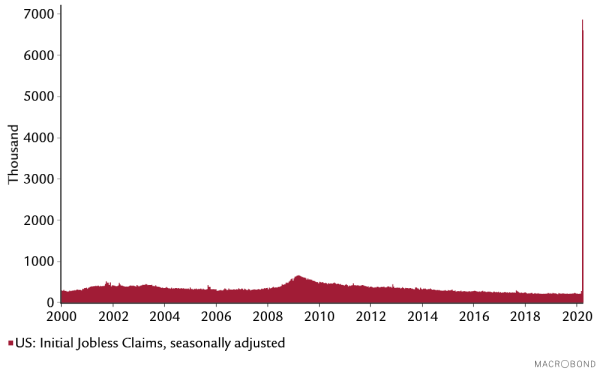
Weekly new unemployment claims in the US.
April 15, 2020
Medical updates
- In the British Telegraph, Professor Alexander Kekulé, one of Germany’s leading microbiologists and epidemiologists, calls for an end to the lockdown as it causes more damage than the virus itself. In people under 50 years of age, severe disease or death are „very, very unlikely“. The general population should develop rapid immunity, while risk groups should be protected. One cannot wait for a vaccine, which will take at least six to twelve months, but must find a way to live with the virus, Professor Kekulé said.
- The German Network for Evidence-Based Medicine reports that the lethality of a severe seasonal influenza (flu) such as 2017/2018 is estimated by the German Robert Koch Institute to be 0.4% to 0.5%, and not only 0.1% as previously assumed. This would mean that the lethality of Covid19 could even be lower than that of a strong seasonal influenza, even though it may spread faster.
- The Luxembourger Tageblatt reports that Sweden’s „relaxed strategy on Covid19 seems to work“. Despite minimal measures, the situation seems to be „clearly calming down at the moment“. A huge field hospital that was set up near Stockholm remains closed due to lack of demand. The number of patients in intensive care units remains constant at a low level or is even slightly declining. „There are many vacancies in intensive care units in all Stockholm hospitals. We are approaching the flattening of the illness curve,“ explained a senior physician at the Karolinska Klinik. So far there have been about 900 deaths with Covid19 in Sweden.
- A direct comparison between the UK (with lockdown) and Sweden (without lockdown) shows that the two countries are almost identical in terms of case numbers and deaths per population.
- A letter to the New England Journal of Medicine reports that in a study of pregnant women, 88% of test-positive women showed no symptoms – a very high figure, but one that is consistent with earlier reports from China and Iceland.
- Professor Dan Yamin, director of the Epidemiology Research Laboratory at Tel Aviv University, explains in an interview that the new corona virus is „hardly dangerous“ for a large part of the population and that rapid natural immunity must be the goal. The money is better spent on extending a clinic than on paying for damages due to the lockdown, he said.
- The president of the Israeli National Research Council, Professor Isaac Ben-Israel, argues that according to current findings, the corona epidemic is over in most countries after about 8 weeks, regardless of the measures taken. He therefore recommends to lift the „lockdown“ immediately.
- The British statistics professor David Spiegelhalter shows that the risk of death from Covid19 corresponds roughly to normal mortality and is visibly increased only for the age group between approx. 70 and 80 years (see the graph at the end of the linked article).
- Professor Karin Moelling, emeritus director of the Institute of Virology at the University of Zurich and an early critic of excessive measures, stresses in a new interview the role of local special factors such as air pollution and population density.
- The British Guardian pointed out in 2015 that extreme air pollution in Chinese cities kills 4000 people per day. This is more than China has so far reported in total Covid19 deaths.
- The German virologist Hendrik Streeck has defended himself against criticism of his pilot study. Streeck found a lethality (based on cases) of 0.37% and a mortality (based on population) of 0.06%, which corresponds to a strong seasonal flu.
- Austrian internal medicine specialists warn of „collateral damage“: Due to the coronavirus, control and operation dates are postponed and fewer patients with heart attack symptoms come to the hospitals.
- A Swiss biophysicist has for the first time graphically depicted the rate of positive Covid19 tests in Switzerland since early March. The result shows that the positive rate oscillates between about 10% and 25% and that the „lockdown“ has had no significant influence (see graph below). Interestingly, Swiss authorities and media have never shown this graph.
- A Swiss researcher has analysed the latest Covid19 report of the Federal Office of Public Health and again comes to a critical assessment: „The situation report is unsuitable for politicians and competent decision making, is highly unspecific, incomplete and lacking in informative value“.
- In a new article, the Swiss chief physician for infectiology, Dr. Pietro Vernazza, explains that the alleged lack of immunity formation in Covid19 is a matter of „rare individual cases or even just clues“, which „on closer inspection do not pose a problem“, but which are „exaggerated and hastily dished up as shocking news“ by some media.
- In France, there are more and more reports of suicides out of fear of the coronavirus or out of fear of having infected someone with the coronavirus.
- The new French site Covid Infos critically examines Covid19 and media reporting.
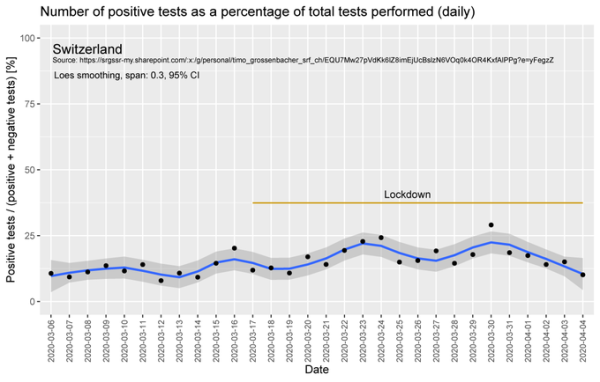
Swiss positive test rate before and during lockdown (FS)
US and UK
- On the US warship Theodore Roosevelt, 600 sailors tested positive for Covid19, and a first sailor has since died from or with Covid19. The warship will be a very important „case study“ for the impact on the healthy general population below 65.
- The emeritus British professor of pathology, Dr John Lee, argues that a robust and evidence-based debate is needed to avoid „big mistakes“. Many of the figures used by governments and the media have not been reliable, he says.
- In the UK, 40% of hospital beds are currently unoccupied, four times more than usual. The reason for this is the sharp decline in general patient admissions. Intensive care beds, whose capacity has been increased, are on average 78% occupied. In addition, 10% of nurses are in quarantine.
- The temporary corona hospitals of the US military near New York are „largely empty“ so far. The hospitalization rate in New York was overestimated by a factor of seven.
- A US study comes to the conclusion that the new corona virus has already spread much further than originally assumed, but causes no or only mild symptoms in most people, so that the lethality rate could be as low as 0.1%, which is roughly equivalent to seasonal flu. However, due to the fact that the disease is more easily transmitted, the cases of the disease in New York, for example, occurred in a shorter time than usual.
- In a new document on the treatment of Covid19 patients, the chief of pneumology and intensive care at Eastern Virginia Medical School states: „It is important to recognize that COVID-19 does not cause your “typical ARDS” (lung failure) … this disease must be treated differently and it is likely we are exacerbating this situation by causing ventilator induced lung injury.“
- In the US, a governor claimed an infant died „of Covid“ as the world’s youngest victim. Family acquaintances, however, stated that the infant had suffocated in a tragic accident at home and subsequently tested positive in hospital. The responsible coroner did not declare a Covid death.
- A doctor from the US state of Montana explained in a speech how death certificates for suspected Covid19 cases are being manipulated due to new guidelines.
Nursing homes
- An analysis of data from five European countries shows that residents of nursing homes have so far accounted for between 42% and 57% of all „Covid19 deaths“. At the same time, three US studies show that up to 50% of all test positive nursing home residents did not (yet) show symptoms at the time of testing. Two conclusions can be drawn from this: On the one hand, the danger of the new coronavirus – as already suspected – seems to be concentrated on a small, very vulnerable population group that needs even better protection. On the other hand, it is conceivable that some of these people may not die, or not only die from the coronavirus, but also from the extreme stress associated with the current situation. Recent reports from Germany and Italy have already mentioned nursing home residents who died suddenly without symptoms.
- A German palliative physician argues in a recent interview that in the treatment of Covid19 patients „very wrong priorities were set and all ethical principles were violated“. There is a „very one-sided orientation towards intensive care“, although „the balance between benefit and harm“ is often not good. A new diagnosis (i.e. Covid19) would turn elderly patients who in the past had mostly been treated palliatively into intensive care patients and subject them to a painful but often hopeless treatment (i.e. artificial respiration). The treatment should always be based on the actual will of the patient, the specialist argued.

Covid19 deaths in nursing homes (LTC Covid)
Political developments
- In Germany, a medical lawyer who filed a complaint against the corona measures with the Federal Constitutional Court and called for demonstrations, was arrested and sent to a prison psychiatric ward for two days. The public prosecutor is investigating for „public provocation to commit crimes“. Another lawyer asks in an open letter to the German Federal Chamber of Lawyers: „Lawyers sent to psychiatric hospital for protest? Is it that time again in Germany?“
- In Switzerland, a „corona critical“ doctor was arrested by a special police unit for alleged „threats against relatives and authorities“ and sent to a psychiatric clinic. The family has since declared that there were no threats against relatives. The doctor also stated that he was not accused of „threats against authorities“ during the interrogation. The police justified the deployment of the special unit by assuming that the doctor was in possession of a weapon – but this was the usual Swiss medical army pistol without ammunition. The transfer of the doctor to a psychiatric clinic was justified on the grounds of an alleged „incapacity to serve in prison“ (as is the case of nursing patients) – this, too, may be seen as a pretext. Based on the current state of knowledge, it is therefore possible that the measure was indeed politically motivated. Former US Congresswoman Cynthia McKinney has already drawn attention to the Swiss case.
- Italy is now using European satellite data to monitor the population during lockdown.
- The British police smashed in a resident’s door looking for „social gatherings“.
- German constitutional law expert Professor Oliver Lepsius: „On the decline of fundamental rights in the corona pandemic“.
April 16, 2020
- The London Times reports that 50% of current British excess mortality might not be caused by the coronavirus, but by the effects of the lockdown, general panic and partial social breakdown. This amounts to 3000 deaths per week. In fact, this figure could be even higher, as the British corona definition also includes deaths with (rather than from) coronaviruses as well as „suspected cases“. In addition, around 50% of „corona deaths“ involve nursing homes, who are not protected any better by a general lockdown.
- In Denmark, the lockdown is now regretted: „We should never have pressed the stop button. The Danish health care system had the situation under control. The total lockdown was a step too far,“ argues Professor Jens Otto Lunde Jørgensen of Aarhus University Hospital. Denmark is currently ramping up school operations again.
- Yale professor David Katz, who warned early on of the negative consequences of a lockdown, gave a detailed one-hour interview on the current situation.
- German virologist Hendrik Streeck explains that no „smear infections“ in supermarkets, restaurants or hairdressing salons have been detected so far.
- New antibody data from the Italian community of Robbio in Lombardy shows that about ten times more people had the corona virus than originally thought, as they developed no or only mild symptoms. The actual immunization rate is 22%.
- New data from the Swiss Canton of Zurich shows that about 50% of all Covid19-related deaths occurred in retirement or nursing homes. Nevertheless, even there about 40% of all test-positive people showed no symptoms. The median age of test-positive deaths in Switzerland is currently about 84 years.
- Pietro Vernazza, the Swiss chief physician for infectiology, comments on the „live with the virus“ strategy and recommends, among other things, individually optimised protection of persons at risk. The immunity of the general population is also a protection for people at risk, he says.
- The new British website Lockdown Skeptics reports critically on Covid19, the measures taken and the general media coverage.
- The Austrian civil society „Initiative for evidence-based corona information“ provides an overview of studies and analyses on the new corona virus
- Documentary: „The WHO – In the grip of the lobbyists“ (ARTE, 2017, German)
April 18, 2020
Medical updates
- A new serological study by Stanford University found antibodies in 50 to 85 times more people than previously thought in Santa Clara County, California, resulting in a Covid-19 lethality of 0.12% to 0.2% or even lower (i.e. in the range of severe influenza). Professor John Ioannidis explains the study in a new video.
- In a new analysis, the Centre for Evidence-Based Medicine (CEBM) at the University of Oxford argues that the lethality of covid19 (IFR) is between 0.1% and 0.36% (i.e. in the range of a severe influenza). In people over 70 years of age with no serious preconditions, the mortality rate is expected to be less than 1%. For people over 80 years of age, the mortality rate is between 3% and 15%, depending on whether deaths so far were mainly with or from by the disease. In contrast to influenza, child mortality is close to zero. With regard to the high mortality rate in Northern Italy, the research group points out that Italy has the highest antibiotic resistance in Europe. In fact, data from the Italian authorities show that around 80% of the deceased were treated with antibiotics, indicating bacterial superinfections.
- The Finnish epidemiology professor Mikko Paunio from the University of Helsinki has evaluated several international studies in a working paper and comes to a Covid19 lethality (IFR) of 0.1% or less (i.e. in the area of seasonal influenza). According to Paunio, the impression of a higher lethality was created because the virus spread very quickly, especially in multi-generation households in Italy and Spain, but also in cities like New York. The „lockdown“ measures had come too late and had not been effective.
- UK: London’s temporary Nightingale hospital has remained largely empty, with just 19 patients being treated at the facility over the Easter weekend. London’s established hospitals have doubled their ICU capacity, and are so far coping with surge.
- In Canada, 31 people died in a nursing home after „almost all nursing staff had left the facility in a hurry for fear of the corona virus spreading. Health authorities found the people in the home in Dorval near Montreal only days later – many of the survivors were dehydrated, malnourished and apathetic.“ Similar tragedies were already reported from northern Italy, where Eastern European nurses left the country in a hurry when panic broke out and lockdown measures were announced.
- A Scottish doctor who also looks after nursing homes writes: „What was the government strategy for nursing homes? The actions taken so far have made the situation much, much worse.“
- In Switzerland, despite Covid19, total mortality in the first quarter of 2020 (until 5th April) was in the medium normal range. One reason for this could be the mild flu season due to the mild winter, which has now been partially „offset“ by Covid19.
- According to a report from April 14, Swiss hospitals and even intensive care units continue to be very under-utilized. This again raises the question of where and how exactly the test-positive deaths (average age 84) in Switzerland actually occur.
- The President of the German Hospital Association has sounded the alarm: more than 50 percent of all planned operations throughout Germany have been cancelled, and the „operations backlog“ is running into thousands. In addition, 30 to 40% fewer patients with heart attacks and strokes are treated because they no longer dare to go to the hospitals for fear of corona. There were 150,000 free hospital beds and 10,000 free intensive care beds nationwide. In Berlin, only 68 intensive care beds are occupied by corona patients, the emergency clinic with 1000 beds is currently not in use.
- New data of German authorities show that in Germany, too, the reproduction rate of Covid19 had already fallen below the critical value of 1 before the lockdown. General hygiene measures were therefore sufficient to prevent the exponential spread. This had already been shown by the ETH Zurich for Switzerland as well.
- On a French aircraft carrier 1081 soldiers tested positive. So far, almost 50% of them remained symptom-free and about 50% showed mild symptoms. 24 soldiers were hospitalized, one of them is in intensive care (previous illnesses unknown).
- Leading German virologist Christian Drosten thinks it is possible that some people have already built up an effective so-called background immunity against the new corona virus through contact with normal common cold corona viruses.
- Klaus Püschsel, a forensic doctor from Hamburg who has already examined numerous test positive deceased, explains in a new article: „The numbers do not justify the fear of corona“. His findings: „Corona is a relatively harmless viral disease. We have to deal with the fact that Corona is a normal infection and we have to learn to live with it without quarantine“. The fatalities he examined would all have had such serious pre-existing conditions that, „even if that sounds harsh, they would all have died in the course of this year. Püschel adds: „The time of the virologists is over. We should now ask others what is the right thing to do in the corona crisis, for example the intensive care doctors.“
- A review on Medscape shows that common cold infections caused by coronaviruses typically decline at the end of April – with or without a lockdown.
- Swiss magazine Infosperber writes: „Fewer corona cases? Just test less!“ The daily number of „new cases“ reported says little about the state of the epidemic. It was reckless to trigger fear with the curve of cumulative test-positive deaths, they argue.
- OffGuardian: Eight more experts questioning the coronavirus panic.
- Video: Why lockdowns are the wrong policy – Swedish expert Prof. Johan Giesecke Swedish epidemiology professor Johan Giesecke speaks of a „tsunami of a mild disease“ and considers lockdowns to be counterproductive. The most important thing, he says, is to provide efficient protection for risk groups, especially nursing homes.

Reproduction number in Germany. Lockdown since March 22. Ban on events with more than 1000 people since March 9 (RKI).
Ventilation with Covid19
Other experts in Europe and the USA have expressed their opinion on the treatment of critical Covid19 patients and strongly advise against invasive ventilation (intubation). Covid19 patients do not suffer from acute respiratory failure (ARDS), but from oxygen deficiency, possibly caused by an oxygen diffusion problem triggered by the virus or the immune response to it.
Political updates
- Video: Police violence and monitoring during corona lockdowns around the world.
- In several US states there have been protests and rallies against the lockdown measures.
- German economist Norbert Haering explains in several articles how the „corona crisis“ is being used to introduce worldwide monitoring instruments that have been planned for some time in the areas of travel, payments, contact tracing and biometrics.
- Giorgio Agamben, Italian philosopher, on the Corona measures: „A country, indeed a culture is imploding right now, and nobody seems to care. What is going on before our eyes in countries that claim to be civilized?“
- Italian lawyers lodged a complaint against corona measures of the government.
- The German professor of economics Stefan Homburg in DIE WELT: „Why Germany’s lockdown is wrong – and Sweden is doing much better“: „In summary, countries like Sweden, South Korea or Taiwan have acted wisely by not using lockdowns. The virologists there guided the population and politicians through the crisis with a steady hand, instead of unsettling them by constantly changing course. The coronavirus was successfully contained without harming fundamental rights and jobs. Germany should take this policy as a model for itself.“
- A Swiss citizen has sent an urgent application to the Federal Administrative Court and the Federal Council to have the lockdown lifted immediately.
- Video: „Swiss doctors were muzzled, the Federal Council is divided.“ An interview with Dr. med. Stephan Rietiker, the founder of InsideCorona.ch
- Video: „The Swiss government belongs in prison. A polemic.“
April 21, 2020
Medical updates
- Stanford professor of medicine John Ioannidis explains in a new one-hour interview the results of several new studies on Covid19. According to Professor Ioannidis, the lethality of Covid19 is „in the range of seasonal flu“. For people under 65 years of age, the mortality risk even in the global „hotspots“ is comparable to the daily car ride to work, while for healthy people under 65 years of age, the mortality risk is „completely negligible“. Only in New York City was the mortality risk for persons under 65 years of age comparable to a long-distance truck driver.
- Professor Carl Heneghan, Director of the Centre for Evidence-Based Medicine at Oxford University, warns in a new article that the damage caused by the lockdown could be greater than that caused by the virus. The peak of the epidemic had already been reached in most countries before the lockdown, Professor Heneghan argues.
- A new serological study in Los Angeles County found that 28 to 55 times more people had Covid19 than previously assumed (without showing significant symptoms), which reduces the danger of the disease accordingly.
- In the city of Chelsea near Boston, about one third of 200 blood donors had antibodies against the Covid19 pathogen. Half of them reported having experienced a cold symptom in the last month. In a homeless shelter near Boston, just over a third of the people tested positive, but nobody showed any symptoms.
- Scotland reports that half of the (stocked up) intensive care beds have remained empty. According to officials, the admission of new patients is „levelling off“.
- The emergency room in Bergamo’s municipal hospital was completely empty at the beginning of this week for the first time in 45 days. In the meantime, more people with other diseases than „Covid19 patients“ are being treated again.
- A report in the medical magazine Lancet comes to the conclusion that school closures to contain corona viruses have no or only a minimal effect.
- A nine-year-old French child with corona infection had contact with 172 people, but none of them were infected. This confirms earlier results that corona infection (unlike influenza) is not or hardly ever transmitted by children.
- The German emeritus microbiology professor Sucharit Bhakdi gave a new one-hour interview on Covid-19. Professor Bhakdi argues that most media have acted „completely irresponsibly“ during the Covid-19 epidemic.
- The German Initiative for Care Ethics criticises blanket bans on visits and painful intensive care treatment of nursing patients: „Even before Corona, around 900 old people in need of care died every day in German homes without being taken to hospital. In fact, palliative treatment, if at all, would be more appropriate for these patients. () According to all we know about Corona so far, there is not a single plausible reason to continue to value infection protection higher than the basic rights of citizens. Lift the inhuman visiting bans!“
- The oldest woman in the Swiss canton of St. Gallen died last week at the age of 109. She survived the „Spanish flu“ of 1918, was not corona-infected and „for her age she was doing very well“. The „corona isolation“, however, had „very much affected her“: „She faded without the daily visits of her family members.“
- The Swiss cardiologist Dr. Nils Kucher reports that in Switzerland currently about 75% of all additional deaths occur not in hospital but at home. This certainly explains the largely emptySwiss hospitals and intensive care units. It is also already known that about 50% of all additional deaths occur in nursing homes. Dr. Kucher suspects that some of these people die of sudden pulmonary embolism. This is conceivable. Nevertheless, the question arises as to what role the „lockdown“ plays in these additional deaths.
- The Italian health authority ISS warns that Covid19 patients from the Mediterranean region, who often have a genetic metabolic peculiarity called favism, should not be treated with antimalarial drugs such as chloroquine, as this can lead to death. This is a further indication that the wrong or overly aggressive medication can make the disease even worse.
- Rubicon: 120 expert opinions on Corona. Worldwide, high-ranking scientists, doctors, lawyers and other experts criticize the handling of the corona virus. (German)
Classification of the pandemic
In 2007, the US health authorities defined a five-tier classification for pandemic influenza and counter-measures. The five categories are based on the observed lethality (CFR) of the pandemic, from category 1 (<0.1%) to category 5 (>2%). According to this key, the current corona pandemic would probably be classified in category 2 (0.1% to 0.5%). For this category, only the „voluntary isolation of sick persons“ was envisaged as the main measure at the time.
In 2009, however, the WHO deleted serverity from its pandemic definition. Since then, in principle, every global wave of influenza can be declared a pandemic, as happened with the very mild „swine flu“ of 2009/2010, for which vaccines worth around 18 billion dollars were sold.
The documentary TrustWHO („Trust who?“), which deals with the dubious role of the WHO in the context of „swine flu“, was recently deleted by VIMEO.
Swiss chief physician Pietro Vernazza: Simple measures are sufficient
In his latest contribution, the Swiss chief physician of infectiology, Pietro Vernazza, uses the results of the German Robert Koch Institute and ETH Zurich to show that the Covid19 epidemic was already under control before the „lockdown“ was even introduced:
„These results are explosive: Both studies show that simple measures such as the renunciation of major events and the introduction of hygiene measures are highly effective. The population is able to implement these recommendations well and the measures can almost bring the epidemic to a halt. In any case, the measures are sufficient to protect our health system in such a way that the hospitals are not overburdened“.

Reproduction rate in Switzerland (ETH/Vernazza)
Switzerland: Cumulative total mortality in the normal range
In Switzerland, cumulative total mortality in the first quarter (until April 5) was at the mean expected value and more than 1500 deaths below the upper expected value. Moreover, by the middle of April the total mortality rate was still more than 2000 deaths below the comparative value from the severe flu season of 2015 (see figure below).

Cumulative mortality compared to medium expected value 2010 to 2020 (BFS)
Sweden: Epidemic ending even without lockdown
The latest figures on patients and deaths show that the epidemic is coming to an end in Sweden. In Sweden, as in most other countries, excess mortality occurred mainly in nursing homes that were not protected well enough, the chief epidemiologist explained.
Compared to other countries, the Swedish population may now benefit from higher immunity to the Covid19 virus, which could better protect them from a possible „second wave“ next winter.
It can be assumed that by the end of 2020, Covid19 will not be visible in the Swedish overall mortality. The Swedish example shows that „lockdowns“ were medically unnecessary or even counterproductive as well as socially and economically devastating.
Video: Why lockdowns are the wrong policy – Swedish expert Professor Johan Giesecke

Test-positive deaths in Sweden (FOHM/Wikipedia; values may still change somewhat)
Anecdotes vs. evidence
In the face of a lack of scientific evidence, some media increasingly rely on gruesome anecdotes in order to maintain fear in the population. A typical example are „healthy children“ who allegedly died of Covid19, but who later often turn out not to have died of Covid19, or who were seriously ill.
Austrian media recently reported about some divers who, six weeks after a Covid19 disease with lung involvement, still showed reduced performance and conspicuous imaging. One section speaks of „irreversible damage“, the next explains that this is „unclear and speculative“. It is not mentioned that divers should generally take a 6 to 12 month break after serious pneumonia.
Neurological effects such as the temporary loss of the sense of smell or taste are also often mentioned. Here too, it is usually not explained that this is a well-known effect of cold and flu viruses, and Covid19 is rather mild in this respect.
In other reports, possible effects on various organs such as kidneys, liver or brain are highlighted, without mentioning that many of the patients affected were already very old and had severe chronic pre-existing conditions.
Political updates
- WOZ: When fear rules. „With drones, apps and demo bans: In the wake of the Corona crisis, fundamental freedoms are being eroded. If we don’t watch out, they will remain so even after the lockdown – but the extreme situation also offers reason for hope.“ (German)
- Multipolar: What is the agenda? „The government praises itself, spreads slogans of perseverance and at the same time slows down the collection of basic data that would allow the reliable measurement of the spread and danger of the virus. In contrast, the authorities are acting quickly and decisively in expanding questionable instruments, such as new „corona apps“ for collective pulse measurement and contact tracing“. (German)
- Professor Christian Piska, expert for public law and legal tech in Vienna: „Austria has changed. Very much so, even if most people seem to just accept it. Step by step, whether the economy is booming or not, we are suddenly living with police-state conditions and severe restrictions on our basic and human rights, which would be a perfect match for dictatorial regimes. () This is Pandora’s box, which once opened, may never be closed again.“ (German)
- More than 300 scientists from 26 countries warn of „unprecedented surveillance of society“ by corona apps violating data protection. Several scientists and universities have already withdrawn from the European contact tracing project PEPP-PT due to a lack of transparency. Recently it became known that the Swiss company AGT is involved in the project, which had previously set up mass surveillance systems for Arab states.
- In Israel, about 5000 people (with a distance of 2m each) demonstrated against the measures of the Netanyahu government: „They talk about an exponential increase of corona cases, but the only thing that increases exponentially are the people who stand up to protect our country and our democracy“.
- Madrid-based Irish journalist Jason O’Toole describes the situation in Spain: „With the military visible on the streets of Spain it’s hard not to describe the situation as martial law in all but name. George Orwell’s Big Brother is alive and well here, with the Spanish police monitoring everybody using CCTV or by flying drones overhead. A staggering 650,000 people were fined and 5,568 arrested during the first four weeks alone. () I was shocked when I watched one video clip of a cop using heavy force to arrest a mentally ill young man who was apparently just walking home with bread.“
- OffGuardian: The disturbing developments in UK policing.
- In a new article, US investigative journalist Whitney Webb writes on „How The US National Security State Is Using Coronavirus To Fulfill An Orwellian Vision“: „Last year, a government commission called for the US to adopt an AI-driven mass surveillance system far beyond that used in any other country in order to ensure American hegemony in artificial intelligence. Now, many of the “obstacles” they had cited as preventing its implementation are rapidly being removed under the guise of combating the coronavirus crisis.“
- In a previous article, Whitney Webb already dealt with the central role of the „Center for Health Security“ at Johns Hopkins University in the current pandemic management as well as its role in previous pandemic and bioweapons simulations and its close links to the US security apparatus.
- The idea of using a pandemic to expand global surveillance and control instruments is not new. As early as 2010, the American Rockefeller Foundation described a „lock step scenario“ in a working paper on future technological and social developments, in which current developments are anticipated with impressive accuracy (pages 18ff).
- „The truth about Fauci“: In a new interview, US virologist Dr. Judy Mikovits talks about her experiences with Dr. Anthony Fauci, who is currently playing a major role in shaping the US government’s Covid19 measures.
- Aid organisations warn that „far more people“ will die from the economic consequences of the measures than from Covid-19 itself. Forecasts now predict that 35 to 65 million people will fall into absolute poverty, and many of them are threatened with starvation.
- In Germany, 2.35 million people are predicted to be on short-time working in 2020, more than twice as many as after the financial crisis of 2008/2009.
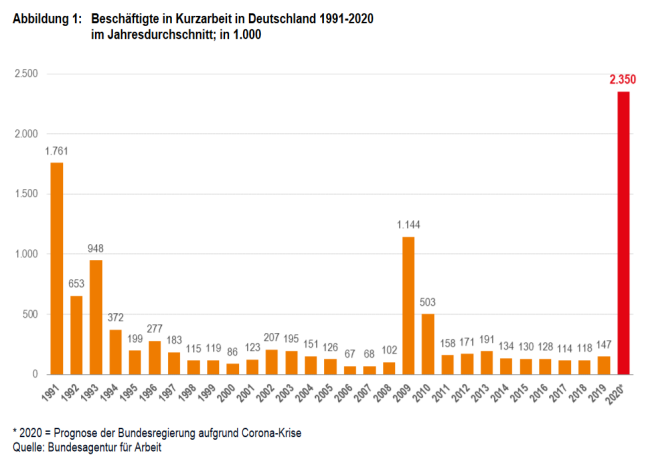
People on short-time working in Germany (BfA)
April 25, 2020
Medical updates
- Professor Detlef Krüger, the direct predecessor of the well-known German virologist Christian Drosten at the Charité Clinic in Berlin, explains in a recent interview that Covid19 is „in many respects comparable to the flu“ and „no more dangerous than certain variants of the flu virus“. Professor Krüger considers the „mouth and nose protection discovered by politicians“ to be „actionism“ and a potential „germ-slinger“. At the same time he warns of „massive collateral damage“ caused by the measures taken.
- The former Swedish and European chief epidemiologist Professor Johan Giesecke gave the Austrian magazine Addendum a candid interview. Professor Giesecke says that 75 to 90% of the epidemic is „invisible“ because that many people develop no or hardly any symptoms. A lockdown would therefore be „pointless“ and harm society. The basis of the Swedish strategy was that „people are not stupid“. Giesecke expects a death rate between 0.1 and 0.2%, similar to that of influenza. Italy and New York had been very poorly prepared for the virus and had not protected their risk groups, Professor Giesecke argues.
- The latest figures from Italy show (pp. 12/13) that 60 of almost 17,000 doctors and nurses who tested positive died. This results in a Covid19 lethality rate of less than 0.1% for those under 50, 0.27% for those aged 50 to 60, 1.4% for those aged 60 to 70, and 12.6% for those aged 70 to 80. Even these figures are likely too high, as these are deaths with and not necessarily from corona viruses, and as up to 80% of people remain asymptomatic and some may not have been tested. Overall, however, the values are in line with those from e.g. South Korea and give a lethality rate for the general population in the range of influenza.
- The head of the Italian Civil Defence declared in mid-April that more than 1800 people died in nursing homes in Lombardy, and that in many cases the cause of death was not yet clear. It was already known beforehand that the care of the elderly and nursing homes and, as a result, the entire health care system in parts of Lombardy had collapsed, in part due to fear of the virus and the lockdown.
- The latest figures from Belgium show that there too, just over 50% of all additional deaths occur in nursing homes, which do not benefit from a general lockdown. In 6% of these deaths Covid19 was „confirmed“, in 94% of the deaths it was „suspected“. About 70% of the test-positive persons (employees and residents) showed no symptoms.
- The British Guardian cites new studies according to which air pollution could be a „key factor“ in Covid19 deaths. For example, 80% of deaths in four countries were in the most polluted regions (including Lombardy and Madrid).
- The Californian physician Dr. Dan Erickson described his observations regarding Covid19 in a much-noticed press briefing. Hospitals and intensive care units in California and other states have remained largely empty so far. Dr. Erickson reports that doctors from several US states have been „pressured“ to issue death certificates mentioning Covid19, even though they themselves did not agree. Dr. Erickson recommends quarantining only the sick and not the healthy or the whole society, as this could have negative effects on health and psyche. A significant increase in „secondary effects“ such as alcoholism, depression, suicide and abuse of children and spouses has already been observed. Based on figures from various countries, Dr. Erickson estimates the lethality of Covid-19 to be about 0.1% or similar to influenza. According to Dr Erickson, a face mask only makes sense in acute situations such as in hospital, but not in everyday life.
- The German newspaper DIE ZEIT focuses on the high vacancy rates in German hospitals, which in some departments are as high as 70%. Even cancer examinations and organ transplants that were not acutely necessary for survival had been cancelled to make room for Covid19 patients, but these have so far been largely absent.
- A new analysis from the UK concludes that there are currently about 2000 people per week dying at home without Covid19 because they cannot or do not want to use the health care system. These are mainly emergency patients with heart attacks and strokes as well as chronically ill people.
- Researchers in Austria concluded that more people died there in March from untreated heart attacks than from Covid19.
- In Germany, a mask requirement was introduced in public transport and in retail outlets. The president of the World Medical Association, Frank Montgomery, has criticized this as „wrong“ and the intended use of scarves and drapes as „ridiculous“. In fact, studies show that the use of masks in everyday life does not bring measurable benefits to healthy and asymptomatic people, which is why the Swiss infectiologist Dr. Vernazza spoke of a „media hype“. Other critics speak of a symbol of „forced, publicly visible obedience“.
- In 2019, a WHO study found „little to no scientific evidence“ for the effectiveness of measures such as „social distancing“, travel restrictions and lockdowns. (Original study)
- A German laboratory stated in early April that according to WHO recommendations, Covid19 virus tests are now considered positive even if the specific target sequence of the Covid19 virus is negative and only the more general corona virus target sequence is positive. However, this can lead to other corona viruses (cold viruses) also trigger a false positive test result. The laboratory also explained that Covid19 antibodies are often only detectable two to three weeks after the onset of symptoms. This must be taken into account so that the actual number of people already immune to Covid19 is not underestimated.
- In both Switzerland and Germany, some politicians have called for „compulsory vaccination against corona“. However, the vaccination against the so-called „swine flu“ of 2009/2010, for example, led to sometimes severe neurological damage, especially in children, and to claims for damages in the millions.
- Professor Christopher Kuhbandner: About the lack of scientific justification for the corona measures: „The reported figures on new infections very dramatically overestimate the true spread of the corona virus. The observed rapid increase in new infections is almost exclusively due to the fact that the number of tests has increased rapidly over time (see figure below). So, at least according to the reported figures, there was in reality never an exponential spread of the coronavirus. The reported figures on new infections hide the fact that the number of new infections has been decreasing since about early or mid-March.“
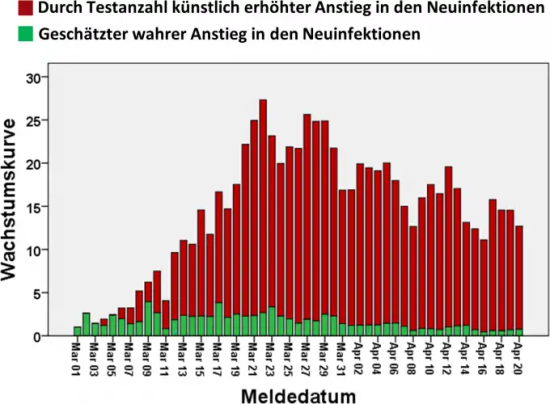
Green: Real increase of infected people; red: increase due to more tests.
Sweden: The media versus reality
Some readers were surprised by the decrease in deaths in Sweden, as most media show a steeply rising curve. What is the reason for this? Most media show cumulative figures by date of reporting, while the Swedish authorities publish the much more meaningful daily figures by date of death.
The Swedish authorities always stress that not all newly reported cases have died within the last 24 hours, but many media ignore this (see graph below). Although the latest Swedish figures may still increase somewhat, as in all countries, this does not change the generally declining trend.
In addition, these figures represent deaths with and not necessarily from coronavirus. The average age of death in Sweden is also over 80 years, about 50% of deaths occurred in vulnerable nursing homes, while the effect on the general population has remained minimal, even though Sweden has one of the lowest intensive care capacities in Europe.
However, the Swedish government has also been given new emergency powers due to „corona“ and could still participate in later contact tracing programmes.
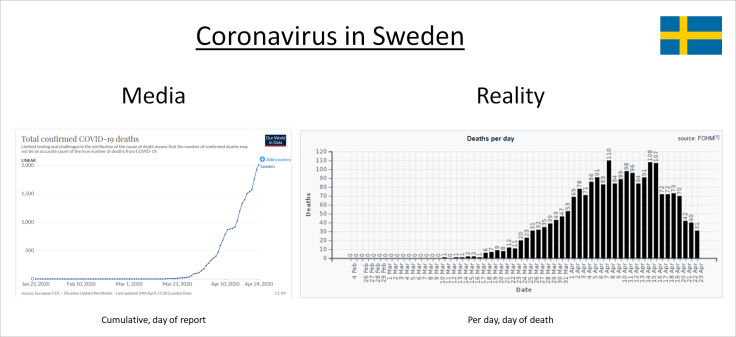
Cumulative deaths by date of reporting vs. daily deaths by date of death. (OWD / FOHM)
The situation in Great Britain
Deaths in the UK have risen sharply in recent weeks, but are still in the range of the strongest flu seasons of the last fifty years (see chart below). In the UK, too, up to 50% of additional deaths occur in nursing homes, which do not benefit from a general lockdown.
Moreover, up to 50% of the additional deaths are said to be non-Covid19 deaths and up to 25% of the additional deaths occur at home. It is therefore not at all clear whether the general lockdown is beneficial or in fact detrimental to society at large.
The editor of the British Spectator has claimed that government agencies expect the lockdown to result in up to 150,000 additional deaths in the longer term, significantly more than what Covid19 is expected to cause. Most recently, the case of a 17-year-old student and singer who took her own life because of the lockdown became known.
It is striking that England, in contrast to most other countries (including Sweden), has a significantly elevated mortality rate even among 15 to 64-year-olds. This could be due to the frequent cardiovascular preconditions, or it might be caused by the effects of the lockdown.
The InProportion project has published numerous new graphs that put current UK mortality in relation to previous flu outbreaks and other causes of death. Other websites that critically review the British situation and measures are Lockdown Skeptics and UK Column.

UK: Weekly all-cause mortality (InProportion)
Switzerland: Excess mortality well below strong flu waves
- A first serological study by the University of Geneva concluded that at least six times more people in the canton of Geneva had contact with Covid19 than previously thought. This means that the lethality of Covid19 in Switzerland also falls well below one percent, while official sources still speak of up to 5%.
- Even in the most severely affected canton of Ticino, almost half of the additional deaths occurred in nursing homes that do not benefit from the general lockdown.
- In Switzerland, 1.85 million people or over a third of all employees have already been registered for short-time work. The economic costs are estimated at 32 billion for the period from March to June.
- Infosperber: Corona: The parroting of the media. „Major media outlets are hiding the fact that they rely on opaque data for Covid-19 numbers.“
- Ktipp: Swiss authorities: Almost all numbers ‚without guarantee‘. „This year fewer under-65s died in the first 14 weeks than in the last five years. Among the over-65s, the number was also relatively low.“
The following graph shows that overall mortality in Switzerland in the first quarter of 2020 was in the normal range and that by mid-April it was still around 2000 people below the flu wave of 2015. 50% of deaths occurred in nursing homes that do not benefit from a lockdown.
Overall, around 75% of the additional deaths occurred at home, while hospitals and intensive care units remain heavily underutilized and numerous operations have been cancelled. In Switzerland, too, the very serious question thus arises as to whether the „lockdown“ may have cost more lives than it saved.
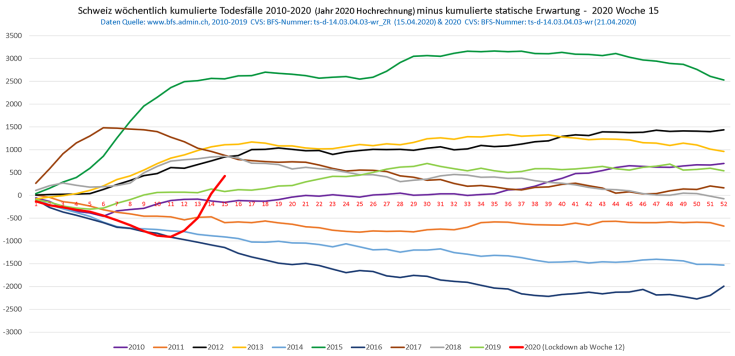
Cumulated deaths compared to expected value, 2010 to 2020 (BFS)
Political updates
- Video: In the Australian state of Queensland, a police helicopter with night-vision equipment tracked down three young men who were drinking a beer on the roof of a house at night, thus violating „Corona regulations“. The men were informed via a megaphone that the building is „surrounded by police“ and that they must proceed to the exit. The men were fined about $1000 each.
- In Israel, the domestic and anti-terrorism intelligence agency Shin Bet, in cooperation with the police, has been tasked to monitor the population’s mobile phones since mid-March in order to track contacts and order house arrest in the context of Covid19. These measures were initially ordered without the consent of Parliament and are due to remain in place until at least the end of April.
- OffGuardian: The Seven Step Path from Pandemic to Totalitarianism
- UK Column: Who controls the British Government response to Covid-19?
- The corona-critical Swiss doctor, who was arrested by a special unit of the Swiss police and sent to a psychiatric clinic (see update of April 15), has meanwhile been released. A report by the magazine Weltwoche revealed that the doctor was arrested on false grounds: there had been no threat to relatives or authorities and there had been no possession of a loaded weapon. Thus, a politically motivated operation seems likely.
- A Munich local radio station, which interviewed doctors critical of corona in March, was informedby the responsible media supervisory authority after complaints that „such problematic broadcasts must be stopped in the future“.
- The website kollateral.news of a German specialist lawyer is collecting reports on „suffering due to the lockdown“ and on the actual situation in German hospitals.
- German general practitioners have published an appeal to politics and science in which they call for „a more responsible handling of the corona crisis“.
- Both in Austria and in Hungary, doctors who have criticised the corona measures are threatened with a ban from their profession.
- In Nigeria, according to official figures, more people have so far been killed by the police enforcing corona curfews than by the corona virus itself.
May 6, 2020
Expert interviews
- Stanford professor John Ioannidis explains in an interview with CNN that Covid19 is a „widespread and mild disease“ comparable to influenza (flu) for the general population, while patients in nursing homes and hospitals should receive extra protection.
- Stanford professor Scott Atlas explains in an interview with CNN that „the idea of having to stop Covid19 has created a catastrophic health care situation“. Professor Atlas says that the disease is „generally mild“ and that irrational fears had been created. He adds that there is „absolutely no reason“ for extensive testing in the general population, which is only necessary in hospitals and nursing homes. Professor Atlas wrote an article at the end of April entitled „The data are in – Stop the panic and end total isolation“ that received over 15,000 comments.
- Epidemiologist Dr Knut Wittkowski explains in a new interview that the danger of Covid19 is comparable to an influenza and that the peak was already passed in most countries before the lockdown. The lockdown of entire societies was a „catastrophic decision“ without benefits but causing enormous damage. The most important measure is the protection of nursing homes. According to Dr. Wittkowski, Bill Gates‘ statements on Covid19 are „absurd“ and „have nothing to do with reality“. Dr. Wittkowski considers a vaccination against Covid19 „not necessary“ and the influential Covid19 model of British epidemiologist Neil Ferguson a „complete failure“.
- German virologist Hendrik Streeck explains the final results of his pioneering antibody study. Professor Streeck found a Covid19 lethality of 0.36%, but explains that this is an upper limit and the lethality is probably in the range of 0.24 to 0.26% or even below. The average age of test-positive deceased was approximately 81 years.
- Biology professor and Nobel Prize winner Michael Levitt, who has been analyzing the spread of Covid19 since February, describes the general lockdown as a „huge mistake“ and calls for more targeted measures, especially to protect risk groups.
- The emeritus microbiology professor Sucharit Bhakdi explains in a new German interview that politics and the media have been conducting an „intolerable fear-mongering“ and an „irres pon sible disinformation campaign“. According to professor Bhakdi, face masks for the general population are not needed and may in fact be harmful „germ catchers“. The current crisis was brought about by the politicians themselves and has little to do with the virus, he argues, while a vaccine against coronavirus is „unnecessary and dangerous“, as was already the case with swine flu. The WHO has „never taken responsibility for its many wrong decisions over the years“, professor Bhakdi adds. (Note: The video was temporarily deleted by YouTube).
- The Swiss chief physician for infectiology, Dr. Pietro Vernazza, explains in a new interview that the Covid19 disease is „mild for the vast majority of people“. The „counting of infected people and the call for more tests“ would not help much. In addition, most of the people listed in the corona statistics did not die solely from Covid-19. According to Dr. Vernazza, there is no evidence for the benefit of face masks in people who do not show symptoms themselves (archive).
Medical studies
- A new overview of existing PCR and antibody studies shows that the median value of Covid19 lethality (IFR) is about 0.2% and thus in the range of a strong influenza.
- A new antibody study with Danish blood donors showed a very low Covid19 lethality (IFR) of 0.08% for persons under 70 years of age.
- A new antibody study from Iran, one of the earliest and most affected countries by Covid19, also showed a very low lethality of 0.08% to 0.12%.
- A new antibody study from Japan comes to the conclusion that about 400 to 800 times more people there had contact with the new coronavirus than previously thought, but showed no or hardly any symptoms. Japan had done rather few tests so far.
- A new study from Germany, with the participation of leading virologist Christian Drosten, shows that about one third of the population already has some cellular immunity to the Covid19 corona virus, presumably through contact with earlier corona viruses (cold viruses). This cellular immunity by so-called T-cells is significantly higher than PCR and antibody tests suggested and may partly explain why many people develop no symptoms with the new coronavirus.
- In a prison in the US state of Tennessee, only two out of 1349 test-positive people showed any symptoms at all.
- On the French aircraft carrier Charles de Gaulle, none of 1046 test-positive sailors have died so far. On the US aircraft carrier Theodore Roosevelt, one of 969 test-positive sailors has died so far (preconditions and exact cause of death are not known). This yields a lethality rate of 0 to 0.1% for this population group.
- Numerous media reported about alleged „re-infections“ of already recovered persons in South Korea. However, researchers have now come to the conclusion that all of the 290 suspected cases were false-positive test results caused by „non-infectious virus fragments“. The result again highlights the well-known unreliability of PCR virus tests.
Other medical updates
- Numerous media reported that in connection with Covid19, more and more children would fall ill with so-called Kawasaki disease (a vascular inflammation). However, the UK’s Kawasaki Disease Foundation issued a press release stating that fewer, not more, Kawasaki cases are currently being reported than usual and that of the few cases reported, only about half had tested positive for corona virus.
- In an open letter to the French Ministry of Health, a French doctor speaks of Covid19 as „the biggest health scam of the 21st century“. The danger of the virus for the general population is in the range of influenza and the consequences of the lockdown are more dangerous than the virus itself, the French doctor argues.
- In France, it became known during a subsequent investigation that the first Covid19-positive patient had already been treated at the end of December 2019, one month earlier than previously assumed. The man was being treated for what appeared to be flu-related pneumonia. This case shows that the new corona virus either arrived in Europe earlier than assumed, or that it is not as new as assumed, or that the test result was a false-positive. In addition, it is not clear whether the man, who has long since recovered, was actually suffering from flu or corona virus or both.
- The Executive Director of the WHO recently praised Sweden as a successful model for handling Covid19. Sweden had implemented its health policy successfully and „in partnership with the population“, he said. Previously, Sweden had been heavily criticized for weeks by foreign media and politicians for its relaxed approach to Covid19.
- Belarus, which took the least action against Covid19 of all European countries and did not even cancel major events like soccer matches, is counting only 103 test-positive or suspected Covid19 deaths after more than two months. The Belarusian long-term president Lukashenko called Corona a „psychosis“. Critics argue he is not disclosing the real number of deaths.
- An extensive literature review by a Canadian researcher found that face masks do not provide measurable protection against colds and influenza.
- A Swiss chief psychiatrist expects a sharp increase in psychological problems and more than 10,000 additional suicides worldwide due to the global lockdown and unemployment.
- The so-called reproduction number, which indicates the proliferation of Covid, is increasingly becoming a political issue. However, this does not change the facts: the peak of the spread was already reached in most countries before the lockdown and the reproduction ratio fell to or below the stable value of one due to simple everyday and hygiene measures. The lockdown was therefore epidemiologically unnecessary.
- The clinical picture and risk groups of Covid19 corona viruses are probably related to the use of the so-called ACE2 cell receptor, which is found in the bronchi and lungs, but also in blood vessels, the intestines and kidneys. However, other coronaviruses, in particular the common cold virus NL63, also use the ACE2 cell receptor. Some researchers therefore expect that the Covid19 coronavirus, too, will be seen as a typical cold virus in the medium term.
- The exact origin of the new corona virus is still unclear. The easiest explanation remains natural transmission or mutation, which happens quite often. It is true, however, that the virological laboratory in Wuhan, as part of a research programme co-financed by the US, studied corona viruses from bats and also examined their transmissibility to other mammals, something that has been criticised for years by some researchers as too risky. The direcotr of the laboratory, however, explained that the new virus did not correspond to the corona viruses investigated in the laboratory. At any rate, earlier rumours about „bioweapons“ or „HIV sequences“ turned out to be disinformation given the relative harmlessness of the corona virus.
Nursing Homes
Nursing homes play an absolutely key role in the current corona situation. In most Western countries, 30% to 70% of all deaths „related to Covid“ occurred in nursing homes (in some regions even up to 90%). It is also known from northern Italy that the crisis there began with a panic-induced collapse of nursing care for the elderly.
Nursing homes require targeted protection and do not benefit from a general lockdown of society. If one looks only at the deaths in the general population, in most countries these are in the range of a normal or even mild wave of influenza.
Moreover, in many cases it is not clear what people in nursing homes really died of, i.e. whether it was Covid19 or stress, fear and loneliness. From Belgium, for example, it is known that about 94% of all deaths in nursing homes are untested „presumed cases“.
A new analysis of French statistics moreover shows the following: as soon as there is a „suspected case“ in a nursing home (e.g. due to coughing), all deaths are considered „suspected Covid19 deaths“, and as soon as there is a „confirmed case“ in a nursing home (even if symptomless), all deaths are considered „confirmed Covid19 deaths“.
A report from Germany vividly describes the extreme conditions under which hundreds of thousands of patients in care and nursing homes have had to live in recent weeks, often against their will. Many of the patients were barely allowed to leave their rooms, were no longer allowed to go out into the fresh air or receive visits from their relatives.
In several nursing homes, the error-prone PCR virus test moreover led to serious false alarms and panic. In one Canadian nursing home, employees fled in fear of the corona virus, resulting in the tragic death of 31 patients due to lack of care.
The former New York Times journalist and Corona critic Alex Berenson writes on Twitter: „Let’s be clear: the fact the nursing home deaths are not front and center every day in elite media coverage of COVID tells you everything you need to know about the media’s priority – which is instilling panic (and punishing Trump), not driving good health policy.“
Full analysis: Mortality associated with COVID-19 outbreaks in care homes: early international evidence (LTC Covid, May 2020)

Deaths in nursing homes, absolute and percentage figures (LTC Covid)
Great Britain
- Cumulative all-cause mortality in the UK remains in the range of the five strongest flu waves in the last 25 years. The peak in daily hospital deaths was already reached on April 8 (s. chart below).
- New statistical data show that in mid-April, out of about 12,000 additional deaths, about 9,000 were „related to Covid“ (including „suspected cases“), but about 3,000 were „not related to Covid“. Moreover, of the total of about 7300 deaths in nursing homes, only about 2000 were „related to Covid“. In both the „Covid19 deaths“ and the non-covid19 deaths, it is often unclearwhat these people actually died of. The Association of British Pathologists has therefore called for a „systematic review of the true causes of death“.
- The temporary „Nightingale“ hospitals in the UK have so far remained largely empty. A similar situation was already seen in China, the US and many other countries.
- At the end of April it became known that the lockdown was apparently not, as officially stated, recommended by a scientific commission alone, but that a high government advisor had „pushed“ the scientists to support the lockdown.
- Peter Hitchens: We’re destroying the nation’s wealth – and the health of millions. „If you don’t defend your most basic freedom, the one to go lawfully where you wish when you wish, then you will lose it for ever. And that is not all you will lose. Look at the censorship of the internet, spreading like a great dark blot, the death of Parliament, the conversion of the police into a state militia.“

England: Test-positive deaths in hosptials (NHS)
United States
- The latest report from the US CDC shows that the Covid19 hospitalization rate among the over-65s is in the range of strong flu waves. It is slightly higher among 18 to 64-year-olds and significantly lower among those under 18.
- Video: A nurse from New York City stated in a dramatic video that New York does „murder“ Covid19 patients by putting them on invasive ventilators and destroying their lungs. The use of the invasive ventilators (instead of oxygen masks) is done „for fear of spreading the virus“. It is „a horror movie“, „not because of the disease, but because of the way it is dealt with“, the nurse explained. Experts have been warning since March against intubation of Covid19 patients.
- Dr. Daniel Murphy, the head of emergency medicine at a heavily affected hospital in New York City, recommends a quick end to the lockdown. According to Dr Murphy, the Covid19 wave had already reached its peak on April 7th. Covid19 is a serious matter, but the fear of it is exaggerated, as the vast majority of the population gets at most mildly ill. His biggest concern now is the sharp decline in the care of emergency patients and children due to the lockdown and the widespread fear in the population.
- Video: The conservative Project Veritas whistleblower platform spoke with New York funeral home directors who stated that currently Covid is written „on all death certificates“ (of suspected cases), whether there was a test or not. Many people are currently dying at home, and often the exact cause of death is no longer checked. The Covid19 statistics are inflated for political or financial reasons, the directors stated.
- The director of the Illinois Department of Health confirmed that even terminally ill people who clearly die of another cause but who test positive for Covid19 virus before or after death are recorded as Covid19 deaths.
- Due to the lockdown, 30 million people in the US have already applied for unemployment benefits by the end of April – that is significantly more than the International Labour Office ILO originally assumed for the entire world.
- Tesla boss Elon Musk called the California curfews „fascist“. The „forced imprisonment“ of people in their homes violates all their constitutional rights, Musk explained in a telephone conference.
- Video: A Wisconsin mother was confronted by police at her home because her children played illegally with neighbor children.
- Video: In late April, some photographers were caught in a partial staging of a protest by care workers against anti-lockdown demonstrators. (Read more).
Switzerland
- Cumulative deaths since the beginning of the year in Switzerland remain within the range of a normal flu epidemic and far below the strong flu epidemic of 2015 (see graph below). Around 50% of deaths occurred in care and nursing homes.
- The Swiss government plans to transform the current corona emergency decrees into a permanent urgent federal law. Most Swiss media have not reported on this far-reaching announcement, or have done so only marginally.
- The Swiss Armed Forces began testing an app for contact tracing that is to be introduced on 11 May in collaboration with Google and Apple. Meanwhile, a Swiss „data protection office“ declared: „If the contact tracing app is suitable and necessary, it does not need to be voluntary“.
- Various vigils were held on the Swiss Bundesplatz in Berne with around 400 participants who spoke out against restrictions on constitutional rights. The rallies were cleared by the police.
- In the context of Covid19 , it was not the long-established Swiss Pandemic Commission that was used, but a newly founded „Covid-19 Task Force“, some of whose members have conflicts of interest in the pharmaceutical sector.
- Video: „Does the Swiss government belong in prison?“ Swiss journalist Reto Brennwald interviewed the entrepreneur Daniel Stricker, who temporarily fled Switzerland to Sweden in mid-March and strongly criticizes the corona policy of the Swiss government.
- A Swiss nurse has written a highly shared article on the current situation. She explains that Swiss hospitals have remained largely empty and in some cases had to furlough staff. She also says it is very unusual to transfer people over 80 years of age to intensive care units because of flu or pneumonia, where they then have to die alone instead of with their families. If this were done, the intensive care units would be overloaded almost every winter. The nurse criticises that most of the media have not sufficiently addressed the recent scientific findings on the rather low overall risk of Covid19.

Cumulative deaths compared to expected deaths, 2010 to 2020 (KW17, BFS/Stotz)
Germany and Austria
- According to a leaked protocol of the Austrian Corona Task Force, Chancellor Kurz is said to have demanded in March that the population should be „more afraid“ of infection or death of parents or grandparents. A strategy paper of the German Federal Ministry of the Interior had already become known earlier, which also called for a psychological fear campaign that was indeed implemented by politicians and the media. In retrospect, the question arises as to how many people died as a result of this largely unfounded fear.
- An open letter with already about 5000 signatures from people over 64 years of age demands: „Corona: Don’t protect us older people at this price! Let us decide for ourselves!“ For the protection of risk groups, the basic rights of the entire society should not be overridden, the authors argue.
- In Austria (and possibly also in other countries) kissing among people in love but not living together is still forbidden. This applies both in public and in one’s own flat, explained the Austrian Minister of Health.
- A German lawyer is currently suing in several courts against the government anti-corona measures, as they are „blatantly unconstitutional“.
- Videos: In Germany there have recently been several cases of serious police overreach. A young woman was brutally arrested by several police officers while shopping, as she had apparently „got 20cm too close“ to a policewoman. Another woman was instructed by the police at a rally not to hold the German constitution in front of her chest, as this was an „illegal political message“. The organizer of a peaceful rally in Berlin was also arrested in a rather brutal fashion. Even older women were arrested in a disproportionate manner. (Caution: disturbing footage of police violence).
Other updates
- The CEO of Youtube announced in an interview at the end of April that video contributions on coronavirus that contradict the guidelines of the WHO or national health authorities will be removed. For example, the video of the two skeptic Californian emergency doctors, which had over five million views, was deleted. Likewise, the interview with Professor Sucharit Bhakdi linked above was at least temporarily removed by Youtube.
- In the US magazine The Atlantic, two law professors wrote an article entitled: „Internet Speech Will Never Go Back to Normal. In the debate over freedom versus control of the global network, China was largely correct, and the U.S. was wrong.“
- Mathias Döpfner, CEO of Axel Springer and one of the most influential media managers in Germany, calls for a „decoupling from China“ and a strengthening of the transatlantic alliance with the USA in the wake of the Corona crisis.
- Washington Post: „The last time the government sought a ‚warp speed‘ vaccine, it was a fiasco“. The 1976 swine flu express vaccination led to paralysis and deaths.
- Looking back: Woodstock Occurred in the Middle of a Pandemic. On the rather relaxed handling of the global flu pandemic of 1968 (read more).
Covid-19 and the media
A lot of people are shocked by the dubious and often fear-mongering Covid19 reporting of many media outlets. Obviously, this is not „ordinary reporting“, but classical and massive propaganda, as it is typically employed in connection with wars of aggression or alleged terrorism.
SPR has depicted the media networks responsible for the dissemination of such propaganda in earlier infographics for the USA, for Germany and for Switzerland. Even the supposedly „open“ Internet lexicon Wikipedia is an integral part of this geopolitical media structure.
The political stance and relationship to power of different media outlets have been analyzed and compared as part of the SPR Media Navigator. The Media Navigator may also be helpful in evaluating the current Covid19 reporting by different media outlets.
If, for example, pictures of soldiers in protective suits disinfecting entire streets are seen on television, this does not prove the danger of the corona virus, but rather – as Professor Giesecke put it benevolently – proves useless „political activism“. Or as others would put it: propaganda.
Covid-19 and mass surveillance
By far the most significant and, from a civil society perspective, the most dangerous development in response to the coronavirus is the apparent political attempt to massively expand mass surveillance and control of society. In this context, NSA whistleblower Edward Snowden warned of the emergence of an „architecture of oppression“.
The flu-like coronavirus may serve as a rationale or pretext for the introduction of strategic measuresto expand monitoring and control of an increasingly uneasy society. The most important instruments currently under discussion by several governments include:
- The introduction of applications for „tracing“ contacts across society
- The establishment of units to enforce the tracing and isolation of citizens
- The introduction of digital biometric ID cards to control and regulate participation in social and professional activities.
- The extended control of travel and payment transactions (including the abolition of cash).
- The creation of a legal basis for access to and intervention in citizens‘ biological systems by governments or corporations (based on so-called „compulsory vaccinations“).
In the US, former President Bill Clinton discussed the introduction of a national network of „contact tracers“ with governors of various states in April. The governor of New York, Andrew Cuomo, then announced that together with billionaire and former New York City mayor Michael Bloomberg, he would create a „contact tracing army“ with up to 17,000 contact tracers for New York.
Meanwhile, in the UK and many other countries, governments are calling for the introduction of biometric „immunity passports“ and presenting them as the allegedly „only way out“ of the primarily politically motivated lockdown. The British Tony Blair Institute called for the „expansion of technological surveillance“ to „combat the corona virus“.
In the US, the Silicon Valley data analysis company Palantir is to play a key role in setting up the data platform for monitoring the (already declining) spread of the corona virus. Palantir is known for its IT projects with intelligence agencies and the military and was founded by US billionaire and Trump supporter Peter Thiel.
In Israel, contact monitoring of the civilian population is carried out by the domestic intelligence service Shin Bet, using programs from the notorious NSO Group, known for its spy software used to monitor civil and human rights activists around the world.
Countries like Russia and China also want to massively expand the surveillance of the population in the wake of the alleged „corona crisis“, but will most likely do so independently of the US.
The idea that a pandemic can be used to expand control of the population is not new: as early as 2010, the American Rockefeller Foundation described a „lock step scenario“ in a report on future technological and social developments, in which current events were anticipated with impressive accuracy (pages 18ff). At the time, the scenario was conceived as a kind of authoritarian „worst case“.
Meanwhile, more than 500 scientists have warned in an open letter against „unprecedented surveillance of society“ through contact tracking apps.
The so-called Center for Health Security at Johns Hopkins University, which is at the heart of the Covid19 pandemic management and which has contributed greatly to the global escalation through its misleading charts, is also very closely linked to the US security apparatus and has been involved in some of its earlier simulations and operations.
In general, cooperation with private actors to achieve geostrategic goals is not a new or unusual phenomenon in US foreign and security policy.
For instance, Microsoft founder Bill Gates, the most important private sponsor of the WHO, the vaccine industry and biometric ID projects, financed a Global Health Program of the US Council on Foreign Relations as early as 2003, which is concerned with the question of how health policy influences geopolitics and, conversely, how health policy can be used to achieve geostrategic goals.
*
Note to readers: please click the share buttons above or below. Forward this article to your email lists. Crosspost on your blog site, internet forums. etc.

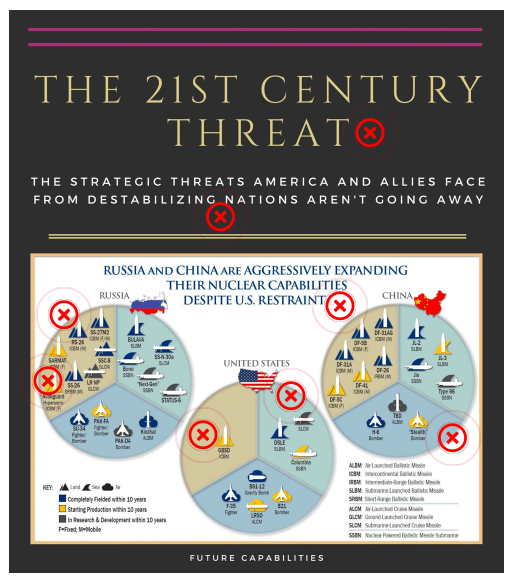
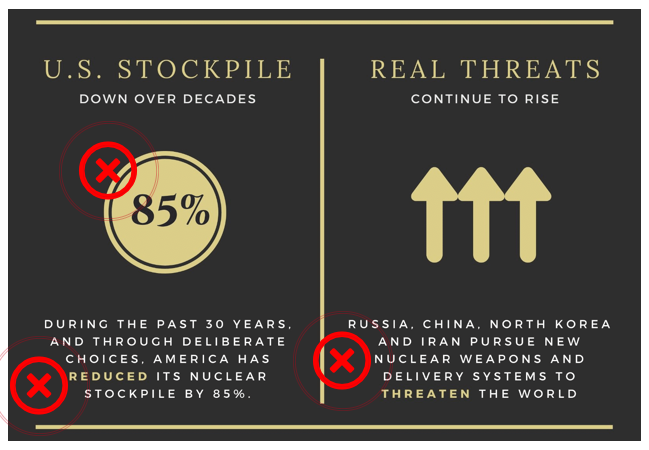
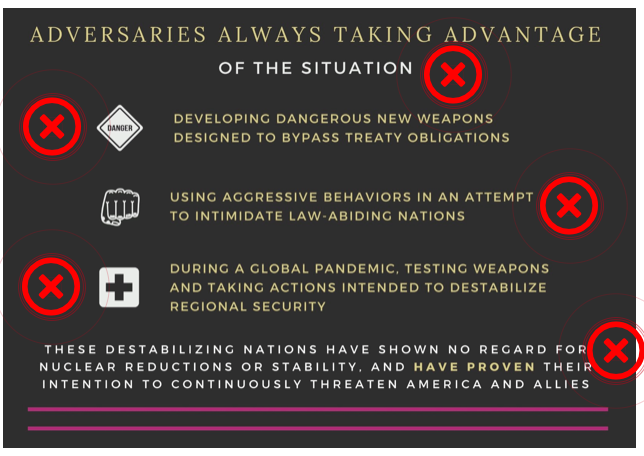






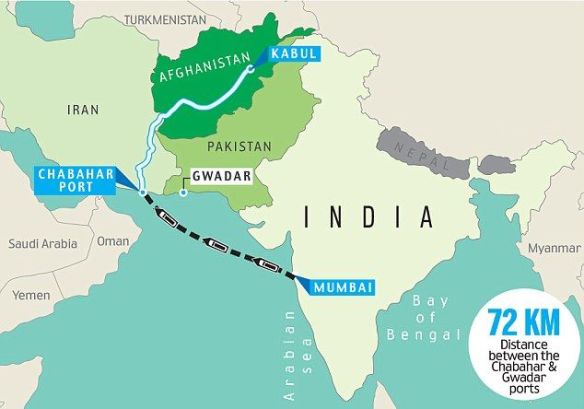


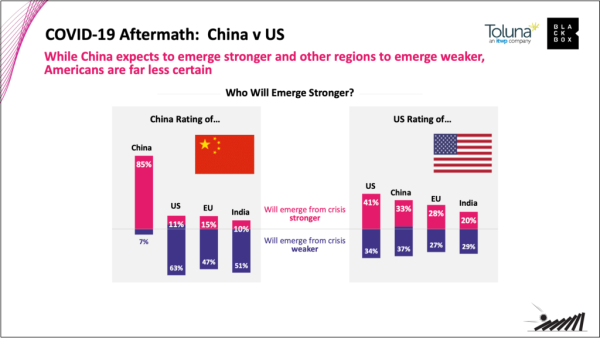
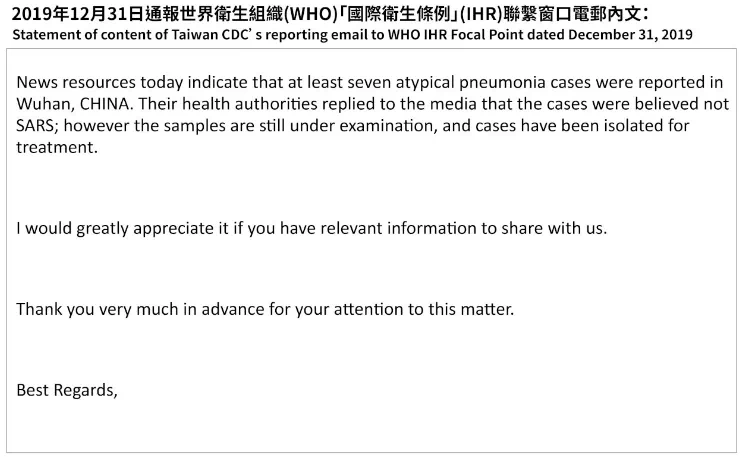





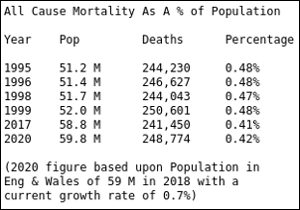









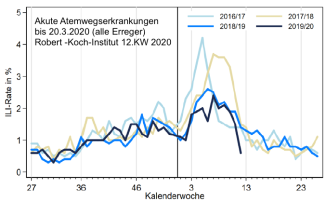
































 Can you
Can you 